Sites: news | india | latam | brasil | indonesia
Feeds: news | india | latam | brasil | indonesia
topic: Mountains
Social media activity version | Lean version
In a Himalayan Eden, a road project promises opportunity, but also loss
- In Nepal’s sacred Tsum Valley, Buddhist community members are conflicted about the ongoing construction of a road that will pass through the region.
- The Tsum Valley is one of the few, if not last, remaining beyul, or sacred valleys, governed by customary and Buddhist laws, where humans and wildlife have lived together in harmony for more than a millennium.
- The valley has maintained its religious and cultural traditions that have conserved biodiversity and its cultural uniqueness due to its remote location.
- The road is part of a government project that aims to connect every town across the country, bringing economic development and government services closer to remote mountainous communities.
Uttarakhand limits agricultural land sales amid protests & tourism development
- Following widespread protests, Uttarakhand’s Chief Minister Pushkar Singh Dhami has issued orders to district magistrates to deny permission to sell agricultural lands to those outside the state.
- With just 14% of its land designated for agriculture and more than 65% of the population relying on agriculture, calls for legislation to safeguard residents’ land rights have intensified.
- With a lack of comprehensive, updated land records, monitoring the usage of farmlands for nonagricultural purposes has become challenging.
- Lack of employment opportunities and resources as well as shifting weather patterns and climate change have pushed numerous farmers to sell their land holdings.
Oman’s mountain oases offer ancient farming lessons for a warming future
- Traditional oasis agriculture in Oman’s northern mountains is an outstanding example of sustainable land-use in dryland ecosystems.
- But major socioeconomic development throughout Oman over the past 50 years means that traditional agricultural practices, more than a millennium old, are changing too.
- Climate change is also affecting the types of crops that can be grown, particularly at higher altitudes.
- The high value of traditional agricultural products, agritourism, and new cash crops offer ideas on how to sustain the economic viability of these mountain oases.
Risky development in Uttarakhand: Interview with environmentalist Ravi Chopra
- Ravi Chopra, an esteemed environmentalist based in Uttarakhand, is renowned for his dedicated efforts to preserve natural resources within the Himalayan region.
- In 2019, the Supreme Court appointed Chopra as chair of a committee to review the controversial Char Dham highway construction project; he later resigned after construction proceeded despite the committtee’s findings that the project could pose significant risks to the ecologically fragile region.
- The Char Dham project drew international attention in November 2023, when a segment of a tunnel collapsed, trapping dozens of workers for 17 days.
- In a recent interview with Mongabay, Chopra discussed the environmental risks and hazards of development in Uttarakhand.
Rare snow leopard sighting in Nepal’s ‘home of tiger’ puzzles conservationists
- Residents of Urlabari town in Nepal’s plains were surprised to spot a snow leopard (Panthera uncia), a species known to live in the mountains.
- Local authorities, including veterinarians, captured the snow leopard, which had sustained injuries, and treated it at the Central Zoo in Kathmandu.
- Conservationists and researchers speculate on the reasons for the snow leopard’s presence in the plains, considering possibilities such as climate change, escape from illegal captivity or disorientation during dispersal.
[Photos] New book is a stunning glimpse of Asia’s wildlife and landscapes
- A new photo book by authors and photographers Bjorn Olesen and Fanny Lai aims to raise awareness of Asia’s impressive biodiversity and protected areas, and inspire mindful ecotourism that supports effective conservation efforts.
- Many of the species intimately featured in the book encapsulate the major challenges facing the region from such threats as climate change, deforestation, development pressure, and the illegal wildlife trade, to name but a few.
- But most of all, the book is a celebration of the region’s biodiversity and conservation successes, featuring the stories of rare and imperiled species brought back from the edge of extinction through protected area management and combined efforts from governments, NGOs and communities.
- Mongabay interviewed Olesen to find out what he’s learned during his photography-inspired travels around the region and share some compelling images printed in the book.
Ancient ocean water found in Himalayas could offer insights about evolution
- A team of researchers from India and Japan have found water droplets trapped in mineral deposits in the Kumaon mountains in the Indian state of Uttarakhand that were likely left from an ancient ocean dating back some 600 million years.
- The scientists say these droplets could aid our understanding of the Neoproterozoic Oxygenation Event and the Earth processes that fostered the evolution of complex life.
- The researchers say these droplets could offer insights about the makeup of ancient oceans and the environment at the time, and they could be helpful for future climate modeling.
Community forest association helps hold the line to protect Mount Kenya forest
- The volunteer members of the Chehe Community Forest Association are playing an active role in protecting forests on the southwestern slopes of Mount Kenya.
- Despite this, 20% of the Afromontane forests in this region have been lost to fire, illegal logging and invasive species over the past 20 years.
- The forest association’s chair says some local residents continue to encroach on forest reserves in the area — and that enforcement could be stronger.
Conservationists condemn Nepal proposal to allow hydropower in protected areas
- The Ministry of Forest and Environment has proposed a new procedure that would allow large-scale hydropower development inside protected areas, with fewer environmental safeguards and more legal loopholes.
- Conservationists and legal experts have criticized the proposal as going against the Constitution and the National Parks and Wildlife Conservation Act as well as risking the biodiversity and ecosystem services of Nepal’s protected areas.
- They have also warned that the proposal could undermine the balance between development and conservation and expose the country to more climate change impacts such as floods and landslides.
- The Department of National Parks and Wildlife Conservation has defended the proposal as documenting the existing practices and bolstering the balance, not upsetting it.
Conservation success lies with governments, not NGOs: Q&A with Hem Sagar Baral
- Hem Sagar Baral is a renowned Nepali ornithologist and conservationist who recently retired as the country representative of the Zoological Society of London.
- In an interview with Mongabay, he talks about his experience setting up ZSL’s office in Nepal, the challenges and achievements of working with various stakeholders, and the role of NGOs in conservation.
- He also emphasizes that NGOs can’t replace the government’s role in conservation, but can only complement it by filling in the gaps and providing technical expertise.
Return of the wolf to Nepal’s Himalayas may threaten snow leopards
- The return of wolves to Nepal’s Himalayan region is putting greater pressure on populations of naur, or blue sheep — and by extension on snow leopards, whose main prey is naur.
- New research shows that naur tend to exhibit greater vigilance in areas where both wolves and snow leopards are present, while lowering their guard somewhat when no wolves are around.
- Conservationists say the growing wolf presence threatens snow leopards through direct competition for food and through stressing out, and weakening, naur populations.
- Snow leopards already face pressure from common leopards and tigers, which are moving further uphill in response to both human threats and a changing climate.
The struggle to deter mining operations in a little-known biodiversity sanctuary in Brazil
- The unprotected southern portion of the Chapada Diamantina mountain range, in the state of Bahia, is in the crosshairs of mining operations, remaining vulnerable to land-grabbing and deforestation.
- This place, known as Serra da Chapadinha, houses threatened species, water reservoirs and an endless supply of scenic beauty.
- There are more than 14,000 hectares (34,600 acres) of areas authorized for mining prospecting in the region, according to open data from the Brazilian Mining Agency.
- The creation of a protected area was recommended to the governor of the state of Bahia.
‘Small mammals play a big role’: Q&A with Nepali researcher Dibya Raj Dahal
- Nepal is renowned for its tigers, rhinos and snow leopards, but the country is also home to a rich diversity of smaller, less-studied mammals.
- These species have long gone overlooked and their research and conservation underfunded, even as they face threats from habitat loss, human-wildlife conflict and climate change.
- In 2008, a group of young Nepali researchers founded the nonprofit Small Mammals Conservation and Research Foundation (SMCRF) to shine a light on these species.
- Dibya Raj Dahal, a lifetime member of the SMCRF since 2009, is now its president, and shares the challenges the organization faces, as well as its hopes for greater recognition of the role of small mammals in Nepal.
Lucky No. 13? Latest images could add to Nepal’s 12 wildcat species
- Nepal is wildcat central, home to 12 feline species — and a new discovery could raise that number to 13.
- Camera trapping last year for a tiger census captured an image of what researchers believe is an Asiatic wildcat (Felis lybica ornata), a felid whose presence in the country has long been debated.
- Locals have a name for the Asiatic wildcat, suggesting it’s been around for a long time, but there’s been no scientific confirmation, experts say.
- To verify its presence would mean getting a DNA and sampling it, for which there’s no funding because it’s not considered a threatened species.
Residents of southeast Alaskan town debate mine that’s bound to change region
- After years of debate, a proposed mine in southeast Alaska near the Chilkat River has a permit to dig an exploratory tunnel and release wastewater.
- The mine has become a divisive topic in the town of Haines, where the Chilkat River sustains the region’s thriving fishing industry.
- Some residents are concerned about how the project could impact salmon in the river and their fishing jobs.
- Others believe the mining companies running the project will be responsible when it comes to protecting the river, while providing jobs in mining.
Fires threaten Afromontane forests’ ‘whole new world’: Q&A with Martim Melo
- A group of international and local scientists has warned of the threat to a key piece of one of Africa’s most threatened habitats: the Afromontane forests that occur in the highlands of western Angola.
- The scientists recently discovered up to 10 new species living in the patches of evergreen forest in the Namba Mountains.
- But pressure from growing human settlements nearby, mainly uncontrolled fires in the grasslands that surround the forests, threatens to overwhelm this unique ecosystem.
- Scientists are calling for the government and international agencies to establish a protected area to preserve this biodiverse hotspot.
Honey production sweetens snow leopard conservation in Kyrgyzstan
- Kyrgyzstan is one of a dozen countries where snow leopards live, but its population of 300-400 of the big cats living along its highest peaks is stressed by climate change, mining, road construction, and conflict with herders, whose livestock can be tempting prey.
- A new program by two snow leopard conservation NGOs is helping herders diversify away from livestock toward beekeeping, agroecology, ecotourism and handicrafts.
- Participants receive beehives and training, and help with education and research into the local snow leopard population via deployment of many camera traps, which so far suggest that the local populations of leopards and a favorite prey species, ibex, are stable or increasing.
- Half of the honey profits are invested back into the program to improve beekeeping education, purchase supplies, and to fund environmental projects chosen by the participants.
In a Bolivian protected area torn up for gold, focus is on limiting damage
- Artisanal gold mining by local cooperatives abounds in protected areas across Bolivia, in particular the Apolobamba highlands near the border with Peru.
- The mining boom here began in the late 1990s, and since then the cooperatives have continued to use mercury amalgamate the gold.
- There are worries over mercury contamination as well as the diversion of river flows away from wetlands to the mines.
- NGOs working with the cooperatives say the local miners are keen on making their operations more sustainable, but that the cost and lack of government support are hurdles to achieving this.
Study shows mountain forests being lost at ‘alarming rate,’ especially in Asia
- More than 7% of mountain forests worldwide were lost between 2001 and 2018, with rates of loss almost doubling after 2010.
- Forest loss varied by region, with tropical mountains losing forests almost three times faster than temperate forests and more than eight times faster than boreal forests.
- The expansion of farming into highland areas of Southeast Asia was a significant cause of this accelerated rate in the tropics during the study period.
- Protected areas help reduce mountain forest loss within their boundaries, particularly in high-biodiversity areas where farming and ranching are the leading causes of deforestation.
Sagarmatha microbes may survive harsh conditions for decades
- Researchers have found microbes on Mount Everest that can survive harsh winds and conditions at some of the world’s highest elevations.
- The research comes at a time when scientists say melting glaciers and permafrost could reawaken viruses and bacteria as the climate warms.
- However, the microbes found on Mount Everest, which were possibly transported by humans through their coughing and sneezing, are unlikely to grow and reproduce, said University of Colorado Boulder scientist Steve Schmidt, a co-author of a new study on the team’s findings.
As Himalayas thaw, snow leopards scramble for habitat: Q&A with Bikram Shrestha
- Snow leopards face a severe prospect of both a shrinking range and fragmented populations as climate change makes their Himalayan homeland less hospitable.
- Bikram Shrestha is a leading snow leopard researcher in Nepal, where he says it’s possible there may not be habitable space for the big cat as temperatures rise.
- He says a key action to conserving snow leopards is to ensure a plentiful supply of prey species, which means ensuring there’s enough suitable habitat for species like Himalayan tahrs and martens.
- Shrestha spoke with Mongabay’s Abhaya Raj Joshi about the need for more research into the world’s most elusive big cat, the prospect of conflict with humans, and why some locals want snow leopards killed.
Himalayan catfight looms as tigers, leopards venture into snow leopard land
- A warming climate threatens to push Nepal’s three big cat species — tigers, leopards and snow leopards — into closer proximity to each other, with unknown consequences for the survival of each.
- Conventional wisdom says tigers prevail in the country’s southern plains, leopards in the mid-country hill region, and snow leopards in the Himalayas.
- But both tigers and leopards have been observed at elevations above 3,000 meters (9,800 feet), well within snow leopard territory, although conservationists say tigers are less likely to persist at these altitudes over the long term.
- A complicating factor is the role of humans, with human settlements also moving up in altitude in search of more suitable conditions, and putting all four apex species in direct competition.
‘Grumpiest cat’ leaves its calling card on the world’s highest mountain
- The presence of the manul, a cold-adapted wild cat the size of a domestic cat, has been confirmed on the slopes of the world’s highest mountain, thanks to scat samples retrieved from there in 2019.
- The confirmation by DNA testing marks the first time the elusive cat has been formally recorded in Nepal’s eastern Himalayan region.
- The first confirmed sighting of the manul, also known as Pallas’s cat, in Nepal came in 2012, in the country’s western Himalayan region.
- Conservationists say the latest finding can help inform conservation actions for the species, including the protection of its prey.
With climate change, Nepal’s leopards get a bigger range — and more problems
- Climate change will make higher-elevation areas of Nepal suitable habitat for leopards, a new study shows.
- This is expected to push the big cats into increased conflict with humans and more competition with snow leopards.
- Most of the current and new habitat will fall outside protected areas, and the leopards’ preferred prey may not be available there, which could prompt the predators to hunt livestock.
- But the finding could also be an opportunity to conserve leopards in their potential new habitat, by educating communities there, ensuring availability of wild prey, and drawing up wildlife management plans.
The tiger in the snow: Cameras capture abundance of life in a Himalayan refuge
- Camera traps have captured tigers roaming at an elevation of 3,165 meters (10,384 feet) in eastern Nepal’s lower Himalayas — the highest they’ve ever been recorded in the country.
- Experts suggest a range of factors for this, including a growing tiger population that’s crowding some of the big cats out of the lowland plains and further uphill.
- Another set of camera trap images were captured in Dadeldhura district in western Nepal, which a previous study identified as a climate refugium, where temperatures remain relatively stable, allowing species to persist during regional and global climate changes.
- Other large mammals have also been recorded on camera trap here, including many that, like tigers, were previously thought to be confined to lower-elevation habitats.
Of Yetis and extinct turtles: Top wildlife discoveries in Nepal in 2022
- Throughout 2022, Mongabay reported on new species discoveries in Nepal, some of them new to science and others spotted for the first time in the country.
- From busting the Yeti myth to highlighting important biodiversity hotspots in need of conservation, the stories helped bring the Himalayan country’s little-known wildlife to a wider audience.
- These are the top six stories related to important scientific discoveries in Nepal this past year.
Crafting Nepal’s conservation success: Q&A with Sharad Chandra Adhikary
- Sharad Chandra Adhikary, a PR veteran who has also worked with Nepal’s anti-corruption commission, now serves as member secretary of the National Trust for Nature Conservation, an organization that works with the government of Nepal.
- The NTNC manages some of the most important conservation areas across Nepal to protect biodiversity, focusing on activities inside protected areas, research by wildlife expert scientists, and helping the government formulate conservation policies.
- The organization works with local communities trying to bring a balance between the local Nepali people’s aspiration for development and keeping the ecological integrity of the areas, encouraging local entrepreneurs in tourism.
‘Bizarre’ newly classified scorpionfly shines light on Nepal’s insect diversity
- After closely examining long-held specimens of insects from Nepal, University of Göttingen zoologist Rainer Willmann has newly described and classified a previously unknown genus of scorpionfly he named Lulilan.
- These scorpionflies have an extremely long abdomen and tail and large genital structure that the male uses to grasp the female during copulation.
- Researchers say the presence of scorpionflies, which are threatened by development, insecticides and disease, indicate a healthy environment — and could be a positive sign for the diversity of Nepal’s insect life.
Work on cable car line to Indonesian volcano to begin despite concerns
- Construction will begin this month on a cable car line to Mount Rinjani on the Indonesian island of Lombok, a UNESCO-listed geopark.
- Environmental activists have expressed concern about the project, noting that local authorities have still not published the environmental impact analysis and feasibility study for public review.
- Authorities insist the cable car line won’t cross into Mount Rinjani National Park, and have touted a series of measures to minimize the environmental impact.
Hunting takes its toll on Himalaya’s blue sheep, favored prey of snow leopards
- Blue sheep in Nepal’s Dhorpatan Hunting Reserve appear to be more wary of humans than those in a nearby conservation area where hunting isn’t permitted, a new study shows.
- Researchers say the behavioral changes, apparently instigated by hunting activity — both legal and illegal — threaten the fitness and well-being of the species.
- They warn this could have a cascading effect on the ecosystem, as blue sheep, also known as bharal, are the favored prey of the region’s snow leopards.
- They also say reserve managers should engage local communities in conservation efforts and in revenue sharing, in a bid to ease the illegal hunting pressure.
Dam construction ignites Indigenous youth movement in southern Chile
- Dam construction on the Bío Bío watershed has plagued Indigenous Mapuche-Pehuenche communities in south-central Chile for decades, with many families having to relocate due to flooding of ancestral lands.
- The 90-megawatt Rucalhue hydropower plant, located near the town of Santa Bárbara, is the latest project causing controversy among local communities, who say they’re sick of battling infrastructure projects that disrespect their culture and traditions.
- Young people have been particularly outspoken against the project, staging sit-ins at the work site, sending petitions to government agencies, and helping organize a local plebiscite.
- Hydropower plants, while less polluting than many other forms of energy generation, still require the clearing of trees and the disrupting of river flows, which can have a significant impact on surrounding ecosystems.
Nepal’s wild yaks ‘need more conservation than research’: Q&A with Naresh Kusi
- In July, researchers Naresh Kusi and Geraldine Werhahn spotted three wild yaks in Nepal, where sightings are rare and the animal was once thought to have gone extinct.
- Kusi spoke with Mongabay about the significance of the sightings of this iconic bovine’s distribution in the region and the need for conservation.
- Wild yaks (Bos mutus) are considered the ancestor of the domesticated yak (Bos grunniens) and hold an important place in the region’s culture and history.
Another winter of discontent as Kathmandu braces for deadly air pollution
- As winter sets in, residents of Kathmandu are bracing for worsening air pollution levels that can exceed by a hundredfold the safe limit prescribed by the WHO.
- The sources of the pollution are both local — vehicle exhaust fumes and burning of garbage — and from further afield, including firecracker residue from festivities in neighboring India.
- A recent study says these combine to give Nepal the highest death rate from chronic lung disease of any country — a problem that experts say the government has repeatedly failed to recognize.
Toxic new frog species from Ecuador named after Family Guy’s Seth MacFarlane
- A new-to-science frog species has been found in Ecuador and named in honor of Seth MacFarlane, the U.S. film and television creator responsible for the show “Family Guy.”
- The frog was found as part of an expedition to catalog and protect species in the Andes. All told, researchers have only found four individual frogs, all within a few square meters of ridgeline atop Cerro Mayordomo, a mountain on the edge of the Amazon basin.
- The frogs’ vibrant patterns likely serve as a warning sign of their toxicity, with researchers reporting burning and tingling skin after collecting the first specimen.
- Ecuador’s forests are home to more than 600 known species of frogs, and more are being described every year. Six other new-to-science species of frogs have been found on Cerro Mayordomo alone.
No time to keep vultures out of danger as new Nepal airport set to open
- With Nepal’s newest international airport set to open at the start of 2023, there’s still no concrete plan to relocate a nearby waste landfill site.
- The site attracts a host of birds, including several threatened vulture species, and conservationists warn there’s a high risk of bird strikes once flights begin.
- They also say it’s too late to relocate the landfill now, with the vultures expected to continue returning to the site for months or even years to come.
- The civil aviation authority says it will take measures to keep the birds away from the airport and out of danger, including with the use of lasers, reflectors and loud noises.
‘Sherpas’ real stories are seldom written’: Q&A with authors Ankit Babu Adhikari & Pradeep Bashyal
- The Indigenous Sherpa communities living in Nepal’s Himalayas find themselves at the forefront of climate change, say the authors of a recent book about the legendary mountaineers.
- Mountaineering has brought a steady source of income for communities living in harsh conditions, but it has also brought with it unprecedented challenges.
- Climate change is making climbing mountains harder and affecting the raising of yaks, considered the lifeline of Sherpa communities.
- To mark the International Day of the World’s Indigenous Peoples, Mongabay spoke to the co-authors of the new book, Sherpa: Stories of Life and Death from the Forgotten Guardians of Everest, about the people who live, work, adapt and survive on the roof of the world.
Thai gold mine blamed for sickening local villagers is set to reopen
- The Chatree mining complex, owned by a subsidiary of Australia’s Kingsgate Consolidated Ltd., began operations in 2001 and was closed by Thailand’s ruling junta in 2017.
- Villagers say the environment and their health has suffered as a result of the operations; mass blood tests found that the majority of children and adults tested exhibited elevated levels of heavy metals, including arsenic, manganese and cyanide.
- The mining company denies allegations that its operations have caused health problems, and in 2017 sued the Thai government for shutting down the mine, seeking “very substantial damages.”
- In January 2022, the government gave permission for the mine to reopen.
Iwan Dento, ‘hero’ of South Sulawesi’s karst mountains
- For more than a decade, environmental activist Iwan Dento has opposed the mining of the limestone karst formations in his homeland of Maros, Indonesia.
- Until 2013, the karst mountain area of Rammang-rammang was mined for marble and limestone, but local resistance led to protective regulations and the establishment of an ecotourism area.
- For his dedication to defending the karst and establishing ecotourism, Iwan Dento has been nominated for several top honors for environmental preservation by both the government and the private sector, and is seen as the “hero” of Rammang-rammang.
In landslide-prone Colombia, forests can serve as an inexpensive shield
- Scientists say that climate change and high deforestation rates will worsen the severity of landslides across Colombia.
- Regular landslides in the country already have a huge human and economic toll; a disaster in Dosquebradas municipality in February killed 14 people after a heavy rainstorm hit the coffee-growing region.
- Yet scientists say that targeted forest restoration and protection offers an inexpensive way to mitigate landslides, with one study in the Colombian Andes showing that it would be 16 times cheaper to invest in forests than to pay the high costs of repairing destroyed roads, power lines and pipelines after landslides.
- Scientists say that using forests to fight landslides would also have major biodiversity benefits in Earth’s second-most biodiverse nation.
‘Sharing the air’ proves a challenge for new Nepal airport in bird paradise
- Conservationists and aviation officials have raised concerns about the potential for bird strikes at a new international airport set to open in Pokhara, Nepal, later this year.
- The flight path to the Chinese-funded airport crosses the habitat of vultures and eagles.
- A landfill site close to the airport also draw these birds of prey, increasing the risk of bird strikes.
- Municipality authorities tasked with relocating the landfill site have still not done so, even as construction of airport nears completion by July.
Civil conflict in Cameroon puts endangered chimpanzees in the crosshairs
- Declared a national park in 2009, Mount Cameroon hosts an array of biodiversity, including endangered Nigeria-Cameroon chimpanzees.
- Efforts to protect the area have been complicated by an armed conflict, the Anglophone crisis, that has displaced hundreds of thousands of people and pushed both refugees and armed combatants into the area’s forests.
- The conflict compounds existing conservation challenges including population pressure, land clearing and conversion, demand for bushmeat, and weak law enforcement.
Tropical deforestation emitting far more carbon than previously thought: Study
- Carbon emissions due to tropical deforestation are accelerating, a new study has found.
- Using detailed maps of forest change as well as aboveground and soil carbon deposits, the researchers demonstrate that annual emission more than doubled between 2015-2019, compared with 2001-2005.
- Though the study reveals that the world has not met its commitments to stem deforestation, the authors say it also reveals that investments in forest protection and restoration are critical to addressing climate change.
Greek conservationists collaborate to protect endemic species in face of climate change
- Across Greece, conservation NGOs are working in close collaboration to study and save numerous endemic species found nowhere else.
- Often working in areas famed for Greek mythology like Mount Olympus and Mount Oiti, the plants and animals now need what seems like divine intervention to survive the ravages brought by climate change.
- Why so many endemic species? Greece has “an amazing diversity of climates and also soils. This creates an amazing diversity of life,” one conservationist tells Mongabay.
EVs from Everest? Chinese lithium find in Himalayas raises concerns over water
- Chinese scientists claim to have found a “super large” deposit of lithium near Mount Everest.
- While reports suggest the deposits are far from the core area of the world’s tallest mountain, the prospect of mining them raises concerns about the impact on water sources, an expert told Mongabay.
- The scientist who led the team that discovered the deposit said more research is needed before a final judgment can be made on the viability of mining in the area.
In Nepal, a messy breakup with hybrid seeds is good news for organic farming
- Some farmers in Nepal are slowly returning to organic farming methods using native crop varieties, after more than a decade of hybrid seeds being available in the market.
- Critics say hybrids require more intensive use of chemical fertilizers and pesticides, and produce fruit and vegetables with less flavor than native or openly pollinated varieties.
- The government is also supporting the push for organic, including through subsidies for farmers, but acknowledges it’s difficult to change minds.
- Many farmers continue to prefer hybrids, despite the associated problems, because of their higher yields, which mean more income.
The small cats nobody knows: Wild felines face intensifying planetary risks
- Around the world, there are 33 species of small wild cat that often fly under the conservation and funding radar. Out of sight, and out of mind, some of these species face the risk of extreme population declines and extinction.
- But small cat species are reclusive and notoriously difficult to study. In some cases, basic ecological knowledge is lacking, hindering conservation efforts. Their failure to garner the public attention achieved by the more charismatic big cats has left small cat research severely underfunded.
- These species, many of them habitat specialists with narrow ecological niches, face a wide array of threats including habitat degradation and loss, poaching, human-wildlife conflict, and increasingly, pollution and climate change.
- Despite these global challenges, many conservationists and researchers, hampered by low funding, are fighting to conserve small cats by partnering with traditional communities to build public awareness and reduce immediate threats.
In Kathmandu, a struggle for water amid worsening floods
- In Kathmandu, residents face the dual challenges of freshwater aquifers running dry, and increasingly unpredictable monsoons causing flash floods.
- The combination of climate change and a rapidly growing urban population is straining an already overwhelmed municipal water system, forcing many residents to have to buy water by the tank at high prices.
- An ambitious project to pipe water to the city from a nearby river was shut down within months of its long-delayed start — a victim of the monsoon floods that destroyed a dam and water treatment plant.
- Another solution being explored is rainwater harvesting, which proponents say should be complemented by restoration of Kathmandu’s green areas and restrictions on drawing groundwater.
Josefina Tunki: ‘If we have to die in defense of the land, we have to die’
- Josefina Tunki, the first woman to preside over the Shuar Arutam People (PSHA), an Indigenous association in Ecuador, faces death threats due to her opposition to mining on Indigenous lands.
- The Ecuadoran government has granted 165 concessions to mining companies — for copper, gold and molybdenum — that covers 56% of PSHA territory in the Condor mountain range in southeastern Ecuador.
- Tunki’s election as president of the PSHA has revealed structural sexism, but it has also shown hope to a generation that sees women like her in positions of power.
- This report is part of a journalistic collaboration between Mongabay Latam and La Barra Espaciadora (The Space Bar).
China’s building spree in Nepal casts shadow over Himalayan ecosystem
- China’s role in Nepal has intensified in the period since the 2015 earthquake, mostly in the form of investments in rebuilding projects. In 2019 alone, China initiated a series of projects, including factories and hydropower plants, worth $2.4 billion in Nepal.
- Many of the infrastructure projects run through sensitive environments, including national parks, and the construction of hydropower plants has been criticized by environmental organizations and local communities for destroying river ecosystems.
- For example, work on the Rasuwagadhi hydroelectric project, part of China’s Belt and Road Initiative, resumed in 2016, despite protests from locals who blamed the dam for mass fish deaths.
As its glaciers melt, Nepal is forced into an adaptation not of its choosing
- Climate change is causing the glaciers in Nepal’s Himalayan region to melt at an alarming rate, threatening fragile ecosystems, vulnerable communities, and billions of people downstream who rely on the rivers fed by the ice pack.
- If global greenhouse gas emissions continue on a business-as-usual trajectory and average global temperatures rise by more than 4°C (7.2°F) by 2100, the Himalayan region could lose up to two-thirds of its glaciers, a study shows.
- For farming communities, this means water shortages, less feed for their livestock, and increased risks of natural disasters such as landslides and glacial lake flash floods.
- The Himalayas are, at present, heating up at rates up to 0.7°C (1.3°F) higher than the global average, and poor communities are already feeling the impacts.
Secrecy shrouds new gold mining deal in Guyana’s Marudi mountains
- A gold mining deal between the government of Guyana and a group of small-scale miners has stirred up controversy as it permits mining on a mountain range that sustains river ecosystems that Indigenous Wapichan communities depend on.
- According to Wapichan leaders, who learned of the deal in a Facebook post, the government violated their right to free, prior and informed consent by issuing the permit without proper consultation and ignoring cases of prior environmental destruction from gold mining.
- Guyana’s Ministry of Natural Resources says at least four consultations were held with Wapichan communities before the agreement was signed.
- The terms of the agreement have not been made public, leaving Indigenous leaders and the deputy speaker of the National Assembly pointing to possible political motives behind the mining deal.
New Himalayan snake found via Instagram
- Locked down at home during the pandemic last year, a postgraduate student in India’s Himalayan region photographed a snake in his backyard that experts had never before seen.
- Uploaded to Instagram, the picture caught the attention of a herpetologist in another part of the country, who set out to find out more about the snake.
- In a newly published paper, they describe it as a new-to-science species of kukri snake (Oligodon spp.).
- The authors say the discovery points to the hidden wealth of biodiversity in the western Himalayas, and call for more studies in this region.
Planned copper mine raises fears for biodiversity hotspot in Jordan
- The Jordanian government plans to carve out almost a third of the Dana Biosphere Reserve to allow mining for copper in the biodiverse area.
- With more than 800 different plants and 215 bird species, Dana is home to about a third of Jordan’s flora, almost half of the country’s mammals, and half of all the bird species.
- Local communities and conservationists have expressed alarm over the plan, warning of irreversible environmental destruction, water and air pollution, and loss of habitat for rare wildlife.
- They also say the environmental impact assessment for the project has never been published, and cite the dangers of long-term contamination, pointing to 2,000-year-old copper mines that continue to pose a toxic threat.
Africa’s montane forests are more carbon-dense than even the Amazon
- Mountain forests store nearly 150 metric tons of carbon dioxide per hectare, a new study estimates, which is more than the Amazon Rainforest per unit area.
- The U.N.’s leading scientific body on climate change, the IPCC, pegs the default value for these forests at 90 metric tons per hectare, underestimating their role in regulating the planet’s climate.
- High-altitude forests cover 16 million hectares (40 million acres) of land in Africa, primarily concentrated in the Democratic Republic of Congo, but about 5% has already disappeared since the turn of the century.
- The study authors say they hope the new estimates will make these forests more attractive for carbon finance initiatives.
‘Red-carded’ Australian miner signals intention to play on in Greenland
- The advancement of a huge rare earths and uranium mining project in Greenland sparked a snap election in April that saw a green party elected and a new government formed that is opposed to the mine.
- The Kvanefjeld project, developed by small Australian mining company Greenland Minerals Limited, with Chinese partner Shenghe Resources, would exploit one of the world’s largest deposits of rare earth metals and uranium near the small township of Narsaq and increase Greenland’s greenhouse gas emissions by 45%.
- While new coalition partners Inuit Ataqatigiit (Party for the People) and Naleraq campaigned against the mine and have a written agreement opposing any uranium mining in Greenland, the consultation process for Kvanefjeld is continuing, and NGOs are concerned that Greenland Minerals will try to pressure the new government to agree to the project in some form.
- In early July, Greenland’s Ministry of Mineral Resources released a draft bill banning uranium mining and exploration and limiting the amount of uranium present as a by-product in any mining operations to 100 parts per million — which would prevent the Kvanefjeld operation going ahead.
Amid historic heat, a climate scientist’s mountain love story (commentary)
- Amid the record heatwaves hitting North America, no community is being spared, whether they are coastal, interior, floodplain or montane.
- A lead author on the High Mountain Areas part of a recent Intergovernmental Panel on Climate Change (IPCC) report shares a love story for these high places that are, she writes, changing rapidly.
- “As a scientist who studies the mountains, there are many tales I could tell in a year when snow melts early, and June is unnaturally hot. I choose this one of a place I love and the people who live here.”
- This article is a commentary, and the views expressed are those of the author, not necessarily Mongabay.
In the Colombian Andes, a forest corridor staves off species extinction
- Recognized as one of the world’s most biodiverse regions, the tropical Andes host more than 10% of the planet’s biodiversity — roughly two million species of plants, animals, fungi and microorganisms — of which only 10% have been identified.
- This precious ecosystem is in peril because, in the past few decades, 75% of natural habitat has been lost largely to agricultural expansion.
- La Mesenia-Paramillo Nature Reserve in the Colombian Andes is attempting to stave off the threat by restoring 3,500 hectares (8,650 acres) of degraded land and connecting about 100,000 hectares (247,000 acres) of intact forest with the main Andean chain as a habitat corridor.
On a Philippine volcano, an eruption-proof mouse rules the roost
- In 1991, a massive eruption at Mount Pinatubo decimated natural old-growth forests, likely resulting in the natural local extinction of several species, a study notes.
- But surveys carried out 20 years after the eruption show that the landscape is regenerating and is dominated by a possibly endemic rodent species, Apomys sacobianus.
- Biologists know Ap. sacobianus from a single specimen collected in 1956; previous studies conducted by the team show it may be specific only to Mount Pinatubo.
- The rodent species is a “disturbance specialist,” meaning that unlike other Apomys species that thrive on mountaintops, Ap. sacobianus has adapted to living in the lowlands due to eruptions in the past.
Are red pandas related to panda bears? Candid Animal Cam meets the furry red creature
- Every Tuesday, Mongabay brings you a new episode of Candid Animal Cam, our show featuring animals caught on camera traps around the world and hosted by Romi Castagnino, our writer and conservation scientist.
Indonesia reopens national parks to tourists as COVID-19 cases rise
- Indonesia is reopening 29 national and nature parks to local and foreign tourists despite a growing number of COVID-19 cases in the country.
- The parks were closed earlier this year to prevent the possible spread of the novel coronavirus to wildlife populations.
- Authorities say the parks will be allowed to open with strict health protocols, including limiting visitors to half capacity.
- Some of the parks allowed for reopening are home to rare and threatened species such as orangutans, proboscis monkeys, Javan hawk-eagles, and silvery gibbons.
COVID-19 prompts closure of Indonesian parks, and a chance to evaluate
- Dozens of Indonesian national parks and conservation sites have been closed temporarily to visitors in an effort to slow the spread of the novel coronavirus in the country.
- Some of the affected sites include popular national parks such as Mount Leuser, Komodo, Rinjani and Way Kambas.
- Conservationists have welcomed the temporary closure, calling it an opportunity for authorities and park operators to evaluate the impacts of tourism on the ecosystems in these areas.
- Indonesia has reported 369 positive cases of COVID-19, the respiratory disease caused by the coronavirus, and 32 deaths as of March 20.
Critics push back as cable car project for Indonesia’s Rinjani is revived
- Authorities on the Indonesian island of Lombok say they want to build a cable car to Mount Rinjani to allow more non-hikers to visit the national park.
- The proposed cable car line would be built outside the park boundaries, but critics say the impact to the environment will ripple into the park itself.
- The government says it plans to complete the project before Lombok hosts the Indonesian leg of next year’s MotoGP racing championship, but a host of studies and permits will be required.
- Rinjani is also part of a global network of UNESCO geoparks, and the cable car project could affect that status when it comes up for evaluation next year.
Mountain gorilla census reveals further increase in numbers
- A census of one of the two populations of mountain gorillas living in eastern Africa revealed an increase from 400 to at least 459 individuals, bringing the total count for the subspecies to 1,069 gorillas.
- Teams conducted the survey in the Bwindi-Sarambwe ecosystem straddling the border between Uganda and the Democratic Republic of Congo in 2018.
- An earlier survey of the other population living in the Virunga Mountains of DRC, Uganda and Rwanda showed that gorilla numbers there are also on the rise.
- That led to a change in the subspecies status on the IUCN Red List from critically endangered to endangered.
Snow leopard population overestimated in Nepal? DNA study suggests it may be
- Researchers conducted a large-scale survey of potential snow leopard habitat in Nepal to re-estimate the species’ population density using the non-invasive technique of collecting environmental DNA from scat samples combined with standard genetic analyses.
- This method enabled the researchers to sample a larger, more representative, area than many previous studies, often conducted in prime leopard habitats; they also found that they could obtain reliable DNA from scat samples.
- Previous studies on which conservation policies have been based may have over-estimated the big cat’s population. The researchers say similar studies are needed to more accurately estimate the population of snow leopards in Nepal and 11 other range countries.
Audio: Exploring a hidden rainforest on an isolated mountain in Mozambique
- On today’s episode of the Mongabay Newscast, we speak with Julian Bayliss, a conservation scientist and explorer who recently discovered a hidden rainforest on top of an isolated mountain in Mozambique.
- Like many other mountains in eastern Africa, Mount Lico is what’s known as an “inselberg” — a German word that means “island mountain.” Bayliss initially spotted the forest atop Mount Lico using Google Earth. He then confirmed its existence via drone reconnaissance, before mounting a campaign to actually scale Mount Lico’s sheer, 410-foot cliffs and explore the forest firsthand.
- On this episode, Julian Bayliss discusses what it was like to behold the unspoiled forest atop Mount Lico for the first time, the new species he found there, and the significance of the pottery he discovered in the rainforest even though no locals have ever been to the top of the mountain.
Camera trap study finds a threatened high-elevation mammal community in Peru
- A new camera trap study, the results of which were published in the journal Oryx last week, seeks to fill in the gaps in our knowledge of the Cerros del Sira’s mammalian inhabitants.
- An international team of scientists from Peru and the UK led by Ruthmery Pillco Huarcaya, a biologist at Peru’s National University of Cusco, deployed 45 camera traps from 2015 to 2016 in the Sira Communal Reserve, part of the Oxapampa-Asháninka-Yánesha Biosphere Reserve.
- Aside from revealing the distribution of and threats to the Cerros del Sira’s mammal community, the results of the camera trap survey led to a number of other insights.
In the Solomon Islands, making amends in the name of conservation
- The Kwaio people of the Solomon Islands have been working with scientists to protect their homeland from resource extraction and development.
- But violent clashes in 1927 between the Kwaio and the colonial government created a rift between members of this tribe and the outside world.
- To heal those old wounds and continue with their conservation work, a trio of scientists joined the Kwaio in a sacred reconciliation ceremony in July 2018.
- Kwaio leaders say that the ceremony opened the door to a more peaceful future for their people.
DRC’s Virunga to welcome visitors again after 8-month closure
- Escalating violence in mid-2018, resulting in the deaths of seven park rangers, forced the closure of Virunga National Park to visitors.
- The park is known for its diverse wildlife, especially its mountain gorillas, as well as its active volcano, but its location in eastern DRC is one of the most volatile regions on earth.
- After assessing the security of the park, officials will reopen stable areas for visitors on Feb. 15 interested in trekking to see the gorillas and to visit the rim of the volcano.
What’s in a name? The role of defining ‘wilderness’ in conservation
- In a recent opinion piece published in the journal Nature, several ecologists question recent efforts to delineate areas of wilderness and intactness around the world to define conservation targets.
- They argue that it would be better to build broadly supported consensus that includes the perspectives of local and indigenous communities.
- But the leader of a team that recently mapped out the remaining wilderness on land and in the ocean said that identifying these areas and developing new targets that incorporate their conservation is critical because current international agreements do not prioritize their protection.
Wildlife rangers in DRC park report waning motivation, job satisfaction
- Surveys of more than 60 rangers in Kahuzi-Biega National Park in eastern Democratic Republic of Congo cite poor salaries, few chances for advancement, and security concerns as reasons for their low satisfaction with their jobs.
- The authors of the study, published in the journal Oryx, believe that the rangers’ discontentment leads to waning motivation in protecting the park and its wildlife, which includes the critically endangered Grauer’s gorilla.
- Improved conditions, in the form of better salaries, opportunities for promotion, and better support from the judicial and legal authorities, could translate into improved protections for the park, the researchers write.
Flashing lights ward off livestock-hunting pumas in northern Chile
- A new paper reports that Foxlights, a brand of portable, intermittently flashing lights, kept pumas away from herds of alpacas and llamas during a recent calving season in northern Chile.
- Herds without the lights nearby lost seven animals during the four-month study period.
- The research used a “crossover” design, in which the herds without the lights at the beginning of the experiment had them installed halfway through, removing the possibility that the herds were protected by their locations and not the lights themselves.
Absent for decades, zebras reintroduced to park in southern Tanzania
- Staff from the Wildlife Conservation Society and its partners in Tanzania released 24 zebras into Kitulo National Park on Oct. 12 and 13.
- The Kitulo Plateau in Tanzania’s southern highlands includes high-elevation grasslands, a unique habitat that requires fire and grazing animals to maintain its plant diversity.
- The reintroduction, with plains zebras from Mikumi National Park, is part of a broader effort to “rewild” the southern highlands after decades of wildlife hunting and livestock grazing.
Secrets revealed: Researchers explore unique, isolated forest in Mozambique
- Researcher Julian Bayliss discovered a forest on Mount Lico by using satellite imagery from Google Earth. In May, Bayliss and a team of more than two-dozen scientists and other experts set out on an expedition to see what kinds of animals and plants lived in the forest.
- According to Bayliss, they found several new species, including a new butterfly.
- Protected by 410-meter cliffs, Mount Lico’s forest is undisturbed by human activity. But the surrounding lowlands – as well as other nearby mountains – are heavily cleared for agriculture.
- These mountains serve as important habitat for unique species, as well as critical water sources for local communities. However, their soil is very fertile and often targeted for cropland. Bayliss says these mountain forests need more conservation attention, and urges the development of programs aimed at balancing local livelihoods with forest preservation.
Fires tear through East Java park, threatening leopard habitat
- Authorities in East Java, Indonesia, are trying to stop a wildfire from spreading into core zone of the Coban Wisula forest, home to Javan leopards.
- The fire is burning within Bromo Tengger Semeru National Park, a major tourist attraction. An iconic landscape in the park, known as Teletubbies Hill, has already gone up in flames.
- A local NGO is monitoring the situation to make sure none of the leopards are flushed out of their habitat and into contact with humans, which could turn violent.
Salamanders have ‘tricks up their sleeves’ for weathering climate change
- North America is the world’s salamander diversity hotspot, and the Appalachian Mountains are home to around 10 percent of all species.
- Salamanders play a big role in forest ecosystems, both as predators and prey, as well as helping keep carbon in the ground.
- Previous research found that global warming stands to make a large portion of the Appalachians unsuitable for salamanders by the end of the century.
- But a new study reveals Appalachian salamanders may be better able to acclimate to warmer, drier conditions than previously believed.
Field Museum honors Peruvian organization for its conservation work with indigenous groups
- The Instituto del Bien Común, a Peruvian organization that works with indigenous communities, has received this year’s Parker/Gentry award for conservation from the Field Museum of Chicago.
- The organization has mapped more than 7,000 indigenous territories in Peru, which serve as a baseline for the Peruvian government on indigenous land.
- The group was also involved in the effort to designate Yaguas National Park, the country’s newest protected area, in January this year.
Bolivia’s Madidi National Park home to world’s largest array of land life, survey finds
- A two-and-a-half-year biological survey of Madidi National Park in Bolivia added 1,382 species and subspecies of plants and animals to the list of those living in the park.
- The team believes that 124 species and subspecies may be new to science.
- WCS, the organization that led the study, said the 18,958-square-kilometer (7,320-square-mile) park is the world’s most biodiverse protected area.
How an island of mice is changing what we know about evolution
- Researchers have identified the smallest-known island where multiple species of mammals evolved from a single founding species. The Philippine island of Mindoro is the size of Yellowstone National Park and host to four species of earthworm mice.
- Genetic analysis indicates all members from these four species descended from just a few individuals that rafted to Mindoro from a neighboring island millions of years ago.
- Three of the species are endemic to Mindoro, and the researchers believe they evolved on different mountains. The study’s findings highlight the pivotal role mountains can play in speciation, and provide evidence that evolution can occur even in small areas.
- The researchers say this underlines the importance of protected areas not just for species preservation, but for species emergence as well. The apparent success of such a small founding population may also give hope for species currently hovering on the precipice of extinction.
New species of shrew discovered on a single mountaintop in the Philippines
- The newly described Palawanosorex muscorum, or the Palawan moss shrew, is known to live only near the peak of Mount Mantalingajan on Palawan Island in the southern Philippines.
- The shrew has a stout body and broad forefeet with long claws, which it uses to dig through humus on the forest floor to look for earthworms.
- The moss shrew has no close known relatives in Asia, and how it came to live on Mount Mantalingajan is a mystery, researchers say.
Warmer winters increasing risk of avalanches in the Himalayas, studies find
- Winters are getting warmer in northwest Himalayas, which is increasing the risk of avalanches, two new studies have found.
- Winter temperatures in the northwestern Himalayas have risen by 0.65 degrees Celsius on average over a period of 25 years, a team of Indian researchers found, which is higher than the global average rise of 0.44 degrees Celsius.
- During this 25-year study period, total winter precipitation also increased, but it was marked by an increase in rainfall and a decrease in snowfall, the study found.
- Rising temperatures have led to an increase in the frequency of avalanches in the Himalayas since 1970, a team of Swiss researchers found.
Mountain lions often lose to wolves and bears, study finds
- When the hunting grounds of pumas overlap with those of other top predators, such as wolves, bears and jaguars, pumas are often the losers, a new study has found.
- The findings from the study, a review of existing scientific literature, are especially important given how pumas are still being intensively hunted over much of their range in a bid to reduce conflicts with people and livestock, researchers say.
- In some puma habitats where wolves and brown bears are recolonizing and recovering, wildlife managers need to be cautious about hunting limits for pumas, the authors write.
Water sources under threat from mining in Ecuador’s mountains
- The Azuay páramos are restricted, alpine ecosystems that exist above the tree line but below the permanent snow line.
- Those who live in southern Ecuador’s páramos oppose gold and copper mining planned for in the region.
- Representatives from a mining company claim that the company won’t affect local communities and that they have permission to work.
Conserving habitat not enough to help species cope with climate change
- New research finds that habitat-based conservation strategies don’t adequately compensate for the range that species in three groups stand to lose due to climate change.
- The team of scientists based in Austria looked at the effects of climate change on 51 species of grasshoppers, butterflies and vascular plants living in central Europe.
- Habitat-based conservation can provide a lifeline, but their model predicts that it won’t be enough to prevent some species from regional extinction.
Stalking snow leopards: Q&A with the director of “Ghost of the Mountains”
- In spring 2014 a crew of filmmakers ventured to the remote mountains of Sanjiangyuan in China’s western province of Qinghai to film the notoriously elusive snow leopard in the wild.
- A new film, “Ghost of the Mountains,” documents that expedition.
- The film is a finalist for Best People and Nature Film in the 2017 Jackson Hole Wildlife Film Festival taking place next week in Jackson, Wyoming.
Collateral damage: Snow leopards and trophy hunting in Kyrgyzstan
- The mountains of Kyrgyzstan provide important connective habitat for endangered snow leopards.
- Government-supported hunting of Marco Polo sheep and Siberian ibex is being blamed for depleting the food supply of snow leopards and driving their numbers down.
- Ecologists say more animals are being hunted than can naturally reproduce, while government representatives contend the harvest is sustainable.
- A bill that would have banned hunting until 2030 was narrowly defeated earlier this year.
New ‘Elfin mountain toad’ discovered in Annamite Mountains of Vietnam
- A team of Russian and Vietnamese researchers described Ophryophryne elfina, the Elfin mountain toad, in the journal ZooKeys last month.
- The toad, one of the smallest species of horned mountain toads ever described to science, was given the name Ophryophryne elfina, which roughly translates to “elfish eyebrow toad” — and the researchers who made the discovery say that there is evidence to suggest that the species could already be considered endangered.
- The species name “elfina,” of course, derives from the English word “elf,” small, magical forest creatures found in German and Celtic folklore.
New leaf-nosed bat uncovered amidst burning habitat in Venezuela
- Using genetic and morphologic comparisons, scientists uncovered a new leaf-nosed bat species they named Sturnia adrianae. The species inhabits montane forest in northern Venezuela and Colombia.
- The species is comprised of two subspecies, one of which is restricted to an isolated mountain range in northeastern Venezuela where human-caused fires are common.
- The study’s lead author recommends increasing conservation and scientific attention for the area to preserve bat habitat, safeguard water supplies, and help prevent landslides like those that recently killed at least 250 people in Mocoa, Colombia.
African bush babies gain a new genus
- Genetic data has pointed toward a unique group of dwarf galagos living in Africa for a long time, but the physical similarity between the primates in the Galago family has confounded scientists.
- Using these genetic clues as a guide, a team of researchers examined the skulls and teeth of galagos and analyzed their calls.
- They concluded that five species previously placed in other genera should be placed in a sixth genus of the family Galagidae. They chose the name ‘Paragalago’ for the new genus.
‘All they need is a head start’: reforesting India’s Western Ghats
- The Western Ghats mountain chain lines South India’s west coast and provides important habitat for many unique species. But development pressure has led to the loss of large areas of forest within and around the range.
- One area that has been particularly hard-hit is the Nilgiris District, in the state of Tamil Nadu. Two centuries of land conversion for timber, tea, and other plantations has displaced much of the region’s native forests and grasslands.
- A team of conservationists is hoping to reverse the deforestation by restablishing native vegetation on degraded land.
- However, the effort is not without its critics who say that it may be more effective to simply let forests come back by themselves.
PHOTOS: On a Chinese mountain, an aging anti-poaching hero ponders the future
- Yu Jiahua, a 65-year old villager living on Jiuding Mountain in Sichuan province, was a skilled hunter when he was in his 20s.
- After an influx of outside poachers severely curtailed local wildlife populations, he and his brother began patrolling the mountain, confronting poachers and confiscating their rifles and snares.
- Eventually Yu convinced other villagers to help, establishing an organization that won outside acclaim and financial support.
- Wildlife on the mountain has rebounded, but finances remain thin and patrollers few. As Yu Jiahua ages, it is unclear who will take on his mission.
Bolivian expedition finds seven new species (PHOTOS)
- The expedition is midway through its two-year exploration of Madidi National Park.
- In addition to species new to science, the researchers have also found multitudes of plants and animals that were not known to live in the park.
- Their next stop is Madidi’s Andean foothills.
‘Bear-moving’ revamped: a better way to reduce conflict in the Himalayas?
- Asiatic black bears are listed as Vulnerable by the IUCN and are under threat from habitat loss and poaching.
- In northern India, bears come into conflict with people when they enter human communities to look for food. These bears are often relocated — or “translocated” — to nearby Dachigam National Park.
- However, bear scientists say translocated bears frequently try to find their way back, running into trouble on the way. They recommend a more multifaceted approach to bear translocation.
Saving the greater sage grouse, the most hotly-debated bird since the spotted owl (PHOTOS)
 A sage grouse struts his stuff. Photo credit: Tom Koerner/USFWS. We try to walk quietly on a path that’s barely lit by a waning moon and the night’s last stars, speaking in hushed whispers as we trip over sagebrush and pant in the thin air. It’s spring, and we‘re trekking across high prairie ranchland in […]
A sage grouse struts his stuff. Photo credit: Tom Koerner/USFWS. We try to walk quietly on a path that’s barely lit by a waning moon and the night’s last stars, speaking in hushed whispers as we trip over sagebrush and pant in the thin air. It’s spring, and we‘re trekking across high prairie ranchland in […]
Super-rare carnivore photographed in Yosemite after missing for nearly a century
 Sierra Nevada fox caught on camera trap in Yosemite National Park. Photo by: National Park Service. For years, biologists believed the Sierra Nevada fox (Vulpes vulpes necator) was down to a single population of around 20 animals in California’s Lassen Volcanic National Park. But then in 2010, biologists found a small population near Sonora Pass. […]
Sierra Nevada fox caught on camera trap in Yosemite National Park. Photo by: National Park Service. For years, biologists believed the Sierra Nevada fox (Vulpes vulpes necator) was down to a single population of around 20 animals in California’s Lassen Volcanic National Park. But then in 2010, biologists found a small population near Sonora Pass. […]
Videos: new film series highlights bringing Gorongosa back to life
 Tracking lions, photographing bats, collecting insects, bringing elephants home: it’s all part of a day’s work in Gorongosa National Park. This vast wilderness in Mozambique—including savannah and montane rainforest—was ravaged by civil war in the 1980s and 90s. However, a unique and ambitious 20-year-effort spearheaded by Greg Carr through the Gorongosa Restoration Project—and partnering with […]
Tracking lions, photographing bats, collecting insects, bringing elephants home: it’s all part of a day’s work in Gorongosa National Park. This vast wilderness in Mozambique—including savannah and montane rainforest—was ravaged by civil war in the 1980s and 90s. However, a unique and ambitious 20-year-effort spearheaded by Greg Carr through the Gorongosa Restoration Project—and partnering with […]
Scientists uncover six potentially new species in Peru, including bizarre aquatic mammal (photos)
 This potentially new lizard species was discovered on the last day of a survey in a cloud forest in Andean Peru. Photo: Luis Mamani. A group of Peruvian and Mexican scientists say they have uncovered at least six new species near South America’s most famous archaeological site: Machu Picchu. The discoveries include a new mammal, […]
This potentially new lizard species was discovered on the last day of a survey in a cloud forest in Andean Peru. Photo: Luis Mamani. A group of Peruvian and Mexican scientists say they have uncovered at least six new species near South America’s most famous archaeological site: Machu Picchu. The discoveries include a new mammal, […]
In the shadows of Machu Picchu, scientists find ‘extinct’ cat-sized mammal
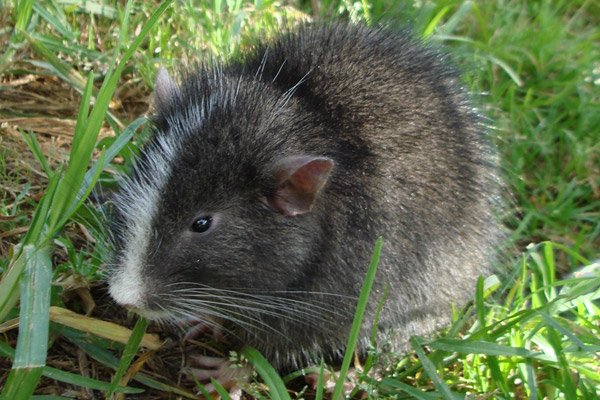 Rediscovered mammal had been slaughtered by the Inca hundreds of years ago The Machu Picchu arboreal chinchilla rat come back to life! Photo by: Roberto Quispe. Below one of the most famous archaeological sites in the world, scientists have made a remarkable discovery: a living cat-sized mammal that, until now, was only known from bones. […]
Rediscovered mammal had been slaughtered by the Inca hundreds of years ago The Machu Picchu arboreal chinchilla rat come back to life! Photo by: Roberto Quispe. Below one of the most famous archaeological sites in the world, scientists have made a remarkable discovery: a living cat-sized mammal that, until now, was only known from bones. […]
Rare bird paradise protected in war-torn Colombian mountain range (photos)
 The Perijá brush-finch has only recently been considered a species in its own right. Photo by: Trevor Ellery. A coalition of conservation groups have established a new protected area in one of Latin America’s most neglected ecosystems: the Colombian-side of the Serranía de Perijá mountain range. Following decades of bloody conflict and rampant deforestation, experts […]
The Perijá brush-finch has only recently been considered a species in its own right. Photo by: Trevor Ellery. A coalition of conservation groups have established a new protected area in one of Latin America’s most neglected ecosystems: the Colombian-side of the Serranía de Perijá mountain range. Following decades of bloody conflict and rampant deforestation, experts […]
Mountain forests store 40 percent more carbon than expected
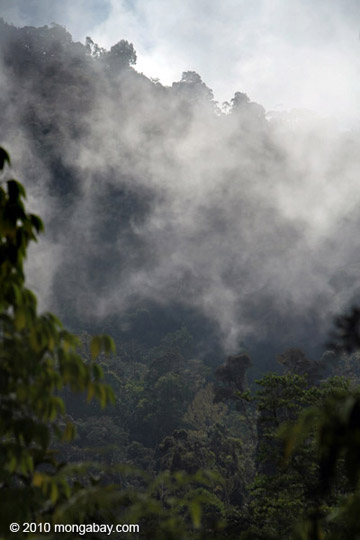 It’s not easy to measure carbon in mountain forest ecosystems. For one thing, climbing into these forests can be difficult, exhausting, and even treacherous. For another, many mountain rainforests are almost constantly blanketed by clouds—hence the term “cloud forest”—making it problematic to measure above-ground carbon storage from the air or satellite. But a new review […]
It’s not easy to measure carbon in mountain forest ecosystems. For one thing, climbing into these forests can be difficult, exhausting, and even treacherous. For another, many mountain rainforests are almost constantly blanketed by clouds—hence the term “cloud forest”—making it problematic to measure above-ground carbon storage from the air or satellite. But a new review […]
A sketch of the yeti: saving the Himalayan brown bear
 Overall, the brown bear is one of the most widespread bear species in the world, found in much of Eurasia and North America, in quite large numbers. A subspecies called the Himalayan brown bear is not so fortunate. It occupies higher reaches of the Himalayas in remote, mountainous areas of Pakistan, Nepal, Tibet and India. […]
Overall, the brown bear is one of the most widespread bear species in the world, found in much of Eurasia and North America, in quite large numbers. A subspecies called the Himalayan brown bear is not so fortunate. It occupies higher reaches of the Himalayas in remote, mountainous areas of Pakistan, Nepal, Tibet and India. […]
After widespread deforestation, China bans commercial logging in northern forests
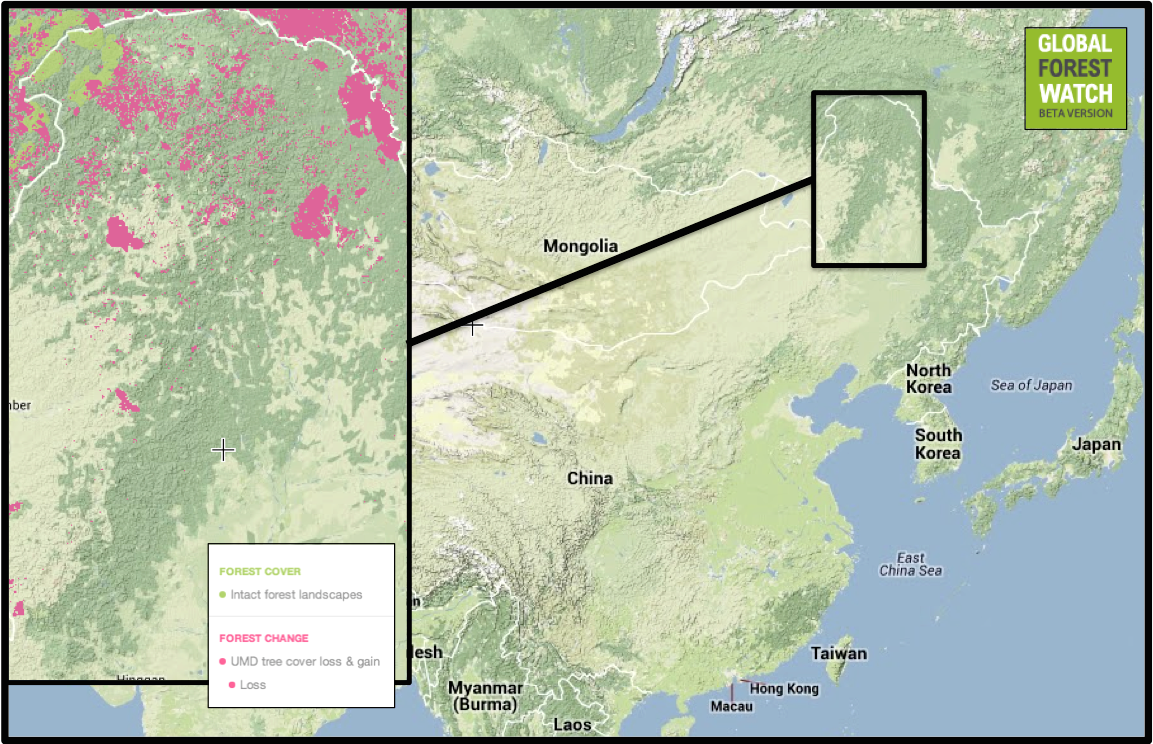 Forestry authorities in China have stopped commercial logging in the nation’s largest forest area, marking an end to more than a half-century of intensive deforestation that removed an estimated 600 million cubic meters (21 billion cubic feet) of timber. The logging shutdown was enacted in large part to protect soil and water quality of greater […]
Forestry authorities in China have stopped commercial logging in the nation’s largest forest area, marking an end to more than a half-century of intensive deforestation that removed an estimated 600 million cubic meters (21 billion cubic feet) of timber. The logging shutdown was enacted in large part to protect soil and water quality of greater […]
Mountain thermostats: scientists discover surprising climate stabilizer that may be key to the longevity of life on Earth
 What do mountains have to do with climate change? More than you’d expect: new research shows that the weathering rates of mountains caused by vegetation growth plays a major role in controlling global temperatures. Scientists from the University of Oxford and the University of Sheffield have shown how tree roots in certain mountains “acted like […]
What do mountains have to do with climate change? More than you’d expect: new research shows that the weathering rates of mountains caused by vegetation growth plays a major role in controlling global temperatures. Scientists from the University of Oxford and the University of Sheffield have shown how tree roots in certain mountains “acted like […]
From theory to deadly reality: malaria moving upslope due to global warming
 Malaria is a global scourge: despite centuries of efforts to combat the mosquito-borne disease, it still kills between 660,000 to 1.2 million people a year, according to World Health Organization data from 2010. Astoundingly, experts estimate that around 300 million people are infected with the disease every year or about 4 percent of the world’s […]
Malaria is a global scourge: despite centuries of efforts to combat the mosquito-borne disease, it still kills between 660,000 to 1.2 million people a year, according to World Health Organization data from 2010. Astoundingly, experts estimate that around 300 million people are infected with the disease every year or about 4 percent of the world’s […]
The price of gold: winners and losers in Latin America’s mining industry
 On a Friday afternoon in June, the Plaza de Armas in Cajamarca is pulsing with life. It’s winter here, and although thick white clouds hover low in the distance, the sun in this northern Peruvian city is warm. Couples sit on benches facing one another. Kids run in the grass between flowerbeds. Men in suits […]
On a Friday afternoon in June, the Plaza de Armas in Cajamarca is pulsing with life. It’s winter here, and although thick white clouds hover low in the distance, the sun in this northern Peruvian city is warm. Couples sit on benches facing one another. Kids run in the grass between flowerbeds. Men in suits […]
Snow leopards and other mammals caught on camera trap in Uzbekistan (photos)
 Scientists knew that snow leopards (Panthera uncia) still survived in the Central Asian country of Uzbekistan, but late last year they captured the first ever photos. Camera traps in the Gissar Nature Reserve took photos of the big cats, along with bear, lynx, ibex, wild boar, and other mammals. The camera trap program was led […]
Scientists knew that snow leopards (Panthera uncia) still survived in the Central Asian country of Uzbekistan, but late last year they captured the first ever photos. Camera traps in the Gissar Nature Reserve took photos of the big cats, along with bear, lynx, ibex, wild boar, and other mammals. The camera trap program was led […]
Yeti may be undescribed bear species
 The purported Yeti, an ape-like creature that walks upright and roams the remote Himalayas, may in fact be an ancient polar bear species, according to new DNA research by Bryan Sykes with Oxford University. Sykes subjected two hairs from what locals say belonged to the elusive Yeti only to discover that the genetics matched a […]
The purported Yeti, an ape-like creature that walks upright and roams the remote Himalayas, may in fact be an ancient polar bear species, according to new DNA research by Bryan Sykes with Oxford University. Sykes subjected two hairs from what locals say belonged to the elusive Yeti only to discover that the genetics matched a […]
Featured video: ‘this is day one for the olinguito’
 Last month scientists unveiled a remarkable discovery: a new mammal in the order Carnivora (even though it mostly lives off fruits) in the Andean cloud forests. This was the first new mammal from that order in the Western Hemisphere since the 1970s. The olinguito had long been mistaken for its closest relatives, olingos—small tree-dwelling mammals […]
Last month scientists unveiled a remarkable discovery: a new mammal in the order Carnivora (even though it mostly lives off fruits) in the Andean cloud forests. This was the first new mammal from that order in the Western Hemisphere since the 1970s. The olinguito had long been mistaken for its closest relatives, olingos—small tree-dwelling mammals […]
Scientists discover teddy bear-like mammal hiding out in Andean cloud forests (photos)
 Teddy bear-like carnivorous creature discovered in South America (photos) While the olinguito looks like a wild, tree-climbing teddy bear with a cat’s tail, it’s actually the world’s newest mammalian carnivore. The remarkable discovery—the first mammal carnivore uncovered in the Western Hemisphere since the 1970s—was found in the lush cloud forests of the Andes, a biodiverse […]
Teddy bear-like carnivorous creature discovered in South America (photos) While the olinguito looks like a wild, tree-climbing teddy bear with a cat’s tail, it’s actually the world’s newest mammalian carnivore. The remarkable discovery—the first mammal carnivore uncovered in the Western Hemisphere since the 1970s—was found in the lush cloud forests of the Andes, a biodiverse […]
China’s growing wine industry threatening pandas and other endangered species
 In 1985, Li Hua visited a valley in the foothills of the Tibetan plateau. The area was better known for its panda population, but the oenologist realized that its high altitude, hours of sunshine, sandy soil and low precipitation also offered ideal conditions for growing grapes. Li’s findings gave local authorities an idea, and over […]
In 1985, Li Hua visited a valley in the foothills of the Tibetan plateau. The area was better known for its panda population, but the oenologist realized that its high altitude, hours of sunshine, sandy soil and low precipitation also offered ideal conditions for growing grapes. Li’s findings gave local authorities an idea, and over […]
Tibetan monks partner with conservationists to protect the snow leopard
 The 2013 Zoos and Aquariums: Committing to Conservation (ZACC) conference runs from July 8th—July 12th in Des Moines, Iowa, hosted by the Blank Park Zoo. Ahead of the event, Mongabay.com is running a series of Q&As with presenters. For more interviews, please see our ZACC feed. Snow leopard. Photo by: Steve Winter/National Geographic. Tibetan monks […]
The 2013 Zoos and Aquariums: Committing to Conservation (ZACC) conference runs from July 8th—July 12th in Des Moines, Iowa, hosted by the Blank Park Zoo. Ahead of the event, Mongabay.com is running a series of Q&As with presenters. For more interviews, please see our ZACC feed. Snow leopard. Photo by: Steve Winter/National Geographic. Tibetan monks […]
Saving Gorongosa: E.O. Wilson on protecting a biodiversity hotspot in Mozambique
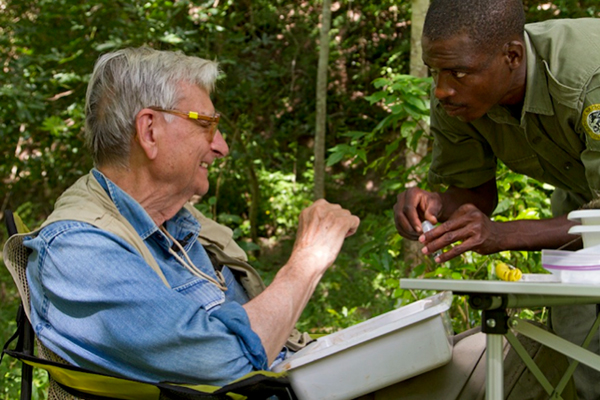 If you fly over the Great African Rift Valley from its northernmost point in Ethiopia, over the great national parks of Kenya and Tanzania, and follow it south to the very end, you will arrive at Gorongosa National Park in central Mozambique. Plateaus on the eastern and western sides of the park flank the lush […]
If you fly over the Great African Rift Valley from its northernmost point in Ethiopia, over the great national parks of Kenya and Tanzania, and follow it south to the very end, you will arrive at Gorongosa National Park in central Mozambique. Plateaus on the eastern and western sides of the park flank the lush […]
Scientists discover two mini-spiders in China (photos)
 Scientists have uncovered two miniature spiders living on mountains in China’s southern region, one of which is among the smallest spiders recorded worldwide, according to a new paper in ZooKeys. Both spiders belong to the Mysmenidae family, which is made up of mini-spiders with eight eyes. “Although the family Mysmenidae is distributed worldwide, it is […]
Scientists have uncovered two miniature spiders living on mountains in China’s southern region, one of which is among the smallest spiders recorded worldwide, according to a new paper in ZooKeys. Both spiders belong to the Mysmenidae family, which is made up of mini-spiders with eight eyes. “Although the family Mysmenidae is distributed worldwide, it is […]
Mount Everest glaciers have shrunk 13% in 50 years
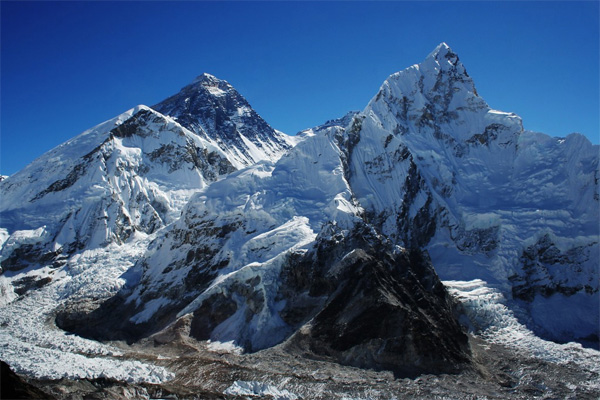 Glaciers in the Mount Everest region have shrunk by 13 percent and the snow-line has shifted 180 meters (590 feet) higher during the past 50 years, according to a study that will be presented this week at a conference organized by the American Geophysical Union. The research, led by Sudeep Thakuri of the University of […]
Glaciers in the Mount Everest region have shrunk by 13 percent and the snow-line has shifted 180 meters (590 feet) higher during the past 50 years, according to a study that will be presented this week at a conference organized by the American Geophysical Union. The research, led by Sudeep Thakuri of the University of […]
U.S. proposes to list wolverine under Endangered Species Act
 Wolverine in the snow. Photo by: Bigstock. Arguably one of the toughest animals on Earth, the wolverine (Gulo gulo) may soon find itself protected under the U.S.’s Endangered Species Act (ESA) as climate change melts away its preferred habitat. Last week, the U.S. Fish and Wildlife Service (FWS) announced it was proposing to place the […]
Wolverine in the snow. Photo by: Bigstock. Arguably one of the toughest animals on Earth, the wolverine (Gulo gulo) may soon find itself protected under the U.S.’s Endangered Species Act (ESA) as climate change melts away its preferred habitat. Last week, the U.S. Fish and Wildlife Service (FWS) announced it was proposing to place the […]
Climate change melting glaciers in the Andes
 Pastoruri Glacier. Photo by: Edubucher/Wikimedia Commons. Glaciers are melting faster than ever in the tropical Andes, warns a new study published in The Cryosphere, which puts the blame for vanishing glaciers squarely on climate change. The study — the most comprehensive to date — found that since the 1970s glacier melt in the region has […]
Pastoruri Glacier. Photo by: Edubucher/Wikimedia Commons. Glaciers are melting faster than ever in the tropical Andes, warns a new study published in The Cryosphere, which puts the blame for vanishing glaciers squarely on climate change. The study — the most comprehensive to date — found that since the 1970s glacier melt in the region has […]
Asia’s third largest animal may be on the rebound
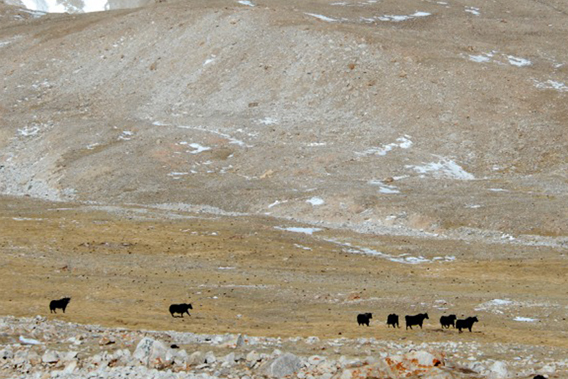 Wild yaks cross the Tibetan Plateau near the edge of a glacier. A scientific team recently counted more than a thousand wild yaks in this region signaling a possible comeback for this species once decimated by over-hunting. Photo by: Joel Berger, WCS/University of Montana. Unlike Asia’s largest animal (the elephant) and its second largest (the […]
Wild yaks cross the Tibetan Plateau near the edge of a glacier. A scientific team recently counted more than a thousand wild yaks in this region signaling a possible comeback for this species once decimated by over-hunting. Photo by: Joel Berger, WCS/University of Montana. Unlike Asia’s largest animal (the elephant) and its second largest (the […]
Mountain pine beetle threatening high-altitude, endangered trees
 Whitebark pine stand. Photo by: Richard Sniezko/U.S. Forest Service. In the western U.S., few trees generally grow in higher altitudes than the whitebark pine (Pinus albicaulis). Providing shelter and food for bears, squirrels and birds, the whitebark pine ecosystems also help regulate water flow from snowmelt. But, according to a new study in the Proceedings […]
Whitebark pine stand. Photo by: Richard Sniezko/U.S. Forest Service. In the western U.S., few trees generally grow in higher altitudes than the whitebark pine (Pinus albicaulis). Providing shelter and food for bears, squirrels and birds, the whitebark pine ecosystems also help regulate water flow from snowmelt. But, according to a new study in the Proceedings […]
Wolves, mole rats, and nyala: the struggle to conserve Ethiopia’s highlands
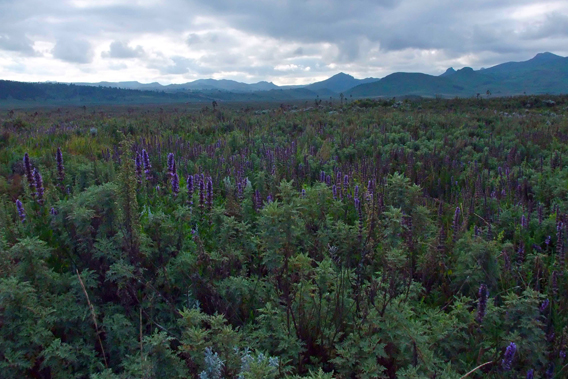 Gaysay Grasslands in Bale Mountains National Park. Photo courtesy of the Frankfurt Zoological Society (FZS). There is a place in the world where wolves live almost entirely off mountain rodents, lions dwell in forests, and freshwater rolls downstream to 12 million people, but the place—Ethiopia’s Bale Mountains National Park—remains imperiled by a lack of legal […]
Gaysay Grasslands in Bale Mountains National Park. Photo courtesy of the Frankfurt Zoological Society (FZS). There is a place in the world where wolves live almost entirely off mountain rodents, lions dwell in forests, and freshwater rolls downstream to 12 million people, but the place—Ethiopia’s Bale Mountains National Park—remains imperiled by a lack of legal […]
Photo: high-altitude bird rediscovered after 80 years
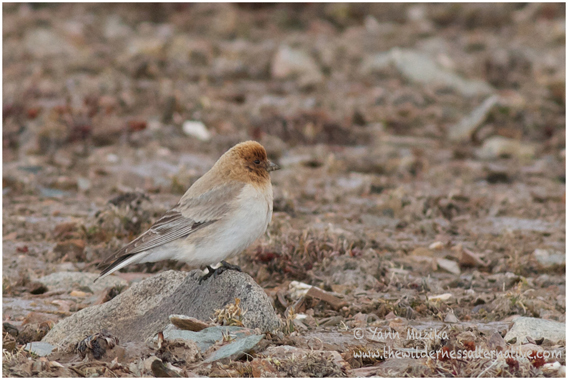 The world’s first photo of a Sillem’s mountain finch. This is a male taken at 5,000 meters above sea level. Photo by: Yann Muzika. In 1929 the U.S. Stock Market collapsed, the Geneva Convention set standards for prisoners of war, the first Academy Awards was celebrated, and Jérôme Alexander Sillem collected two bird specimens on […]
The world’s first photo of a Sillem’s mountain finch. This is a male taken at 5,000 meters above sea level. Photo by: Yann Muzika. In 1929 the U.S. Stock Market collapsed, the Geneva Convention set standards for prisoners of war, the first Academy Awards was celebrated, and Jérôme Alexander Sillem collected two bird specimens on […]
Cute animal picture of the day: red panda kits
 Twin red panda girls were recently born at the Zoological Society of London’s (ZSL) Whipsnade Zoo. They have been named Ying and Yang. Photo by: ZSL Whipsnade Zoo. Although called red pandas, these Asian animals are neither pandas nor bears, and despite a resemblance to raccoons they are not closely related to them either. Red […]
Twin red panda girls were recently born at the Zoological Society of London’s (ZSL) Whipsnade Zoo. They have been named Ying and Yang. Photo by: ZSL Whipsnade Zoo. Although called red pandas, these Asian animals are neither pandas nor bears, and despite a resemblance to raccoons they are not closely related to them either. Red […]
Photos: new mammal menagerie uncovered in remote Peruvian cloud forest
 Possible new species of night monkey in the Aotus genus. Photo by: Alexander Pari. Every year scientists describe around 18,000 new species, but mammals make up less than half a percent of those. Yet mammal surprises remain: deep in the remote Peruvian Andes, scientists have made an incredible discovery: a rich cloud forest and alpine […]
Possible new species of night monkey in the Aotus genus. Photo by: Alexander Pari. Every year scientists describe around 18,000 new species, but mammals make up less than half a percent of those. Yet mammal surprises remain: deep in the remote Peruvian Andes, scientists have made an incredible discovery: a rich cloud forest and alpine […]
Scientists name new snake species to criticize mine plans in Panama (photos)
 New snail-eating snake from Panama: Sibon noalamina. Non-venomous snail-eating snakes sport bright colors to mimic poisonous snakes as a defense. Photo © Sebastian Lotzkat. While scientists increasingly name new species after celebrities in order to gain much-needed attention for the world’s vanishing biodiversity, researchers describing a new snake species from Panama have taken a different […]
New snail-eating snake from Panama: Sibon noalamina. Non-venomous snail-eating snakes sport bright colors to mimic poisonous snakes as a defense. Photo © Sebastian Lotzkat. While scientists increasingly name new species after celebrities in order to gain much-needed attention for the world’s vanishing biodiversity, researchers describing a new snake species from Panama have taken a different […]
Pictures: Bolivian park may have the world’s highest biodiversity
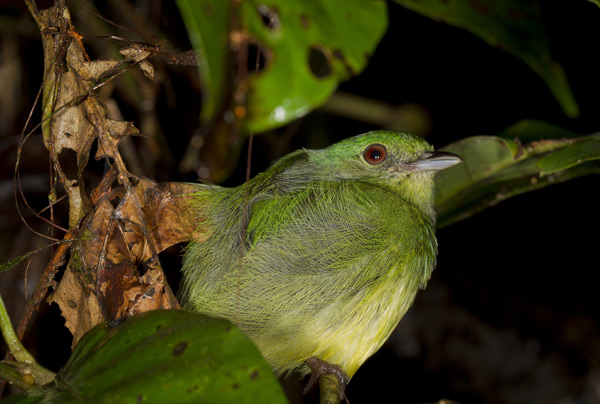 A female blue crowned manakin (Lepidothrix coronata) is one of over a thousand known bird species in Madidi National Park. Photo by: Mileniusz Spanowicz/WCS. With over 90 species of bat, 50 species of snake, 300 fish, 12,000 plants, and 11 percent of the world’s bird species, Madidi National Park in Bolivia may be the world’s […]
A female blue crowned manakin (Lepidothrix coronata) is one of over a thousand known bird species in Madidi National Park. Photo by: Mileniusz Spanowicz/WCS. With over 90 species of bat, 50 species of snake, 300 fish, 12,000 plants, and 11 percent of the world’s bird species, Madidi National Park in Bolivia may be the world’s […]
‘The lion of the cave:’ new predatory, swimming cricket discovered in Venezuela
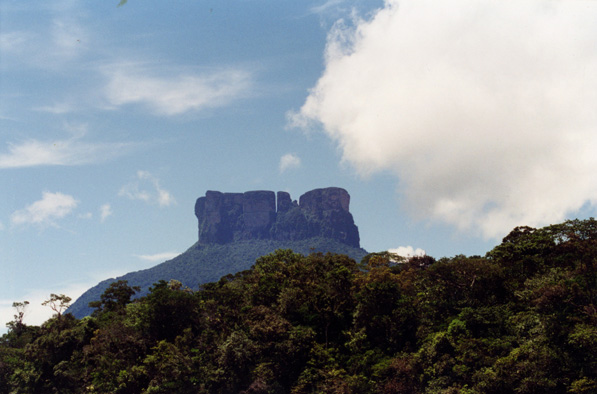 Tepui, or flat-topped mountain, in Venezuela. Photo by: Rhett A. Butler. Scientists have discovered what is likely a new species of cricket that is the top predator of its lightless world: a cave in a Venezuelan tepui. The fauna of cave was documented by BBC filmmakers as researchers uncovered not only a large, flesh-eating cricket […]
Tepui, or flat-topped mountain, in Venezuela. Photo by: Rhett A. Butler. Scientists have discovered what is likely a new species of cricket that is the top predator of its lightless world: a cave in a Venezuelan tepui. The fauna of cave was documented by BBC filmmakers as researchers uncovered not only a large, flesh-eating cricket […]
Conservationists pledge to double number of tiny buffalo
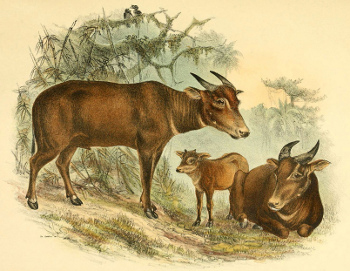 Ten thousand mighty tamaraw buffalo (Bubalus mindorensis) once grazed the mountain slopes of Mindoro Island in the Philippines. However, these dwarf buffalo are now classified as Critically Endangered on the IUCN Red List, with fewer than 300 individuals remaining on the small island to which they are wholly endemic. Yet hope remains for the tamaraw: […]
Ten thousand mighty tamaraw buffalo (Bubalus mindorensis) once grazed the mountain slopes of Mindoro Island in the Philippines. However, these dwarf buffalo are now classified as Critically Endangered on the IUCN Red List, with fewer than 300 individuals remaining on the small island to which they are wholly endemic. Yet hope remains for the tamaraw: […]
Conservation success: markhor population climbing
 Pakistan’s national mammal, the markhor, is making a remarkable comeback in the country as a result of community conservation efforts, according to the Wildlife Conservation Society (WCS). Surveys this year in the Kargah region of Northern Pakistan’s Gilgit Baltistan territory, have estimated 300 individuals of this large wild goat, up from a low of 40-50 […]
Pakistan’s national mammal, the markhor, is making a remarkable comeback in the country as a result of community conservation efforts, according to the Wildlife Conservation Society (WCS). Surveys this year in the Kargah region of Northern Pakistan’s Gilgit Baltistan territory, have estimated 300 individuals of this large wild goat, up from a low of 40-50 […]
New mammal discovered in Indonesia
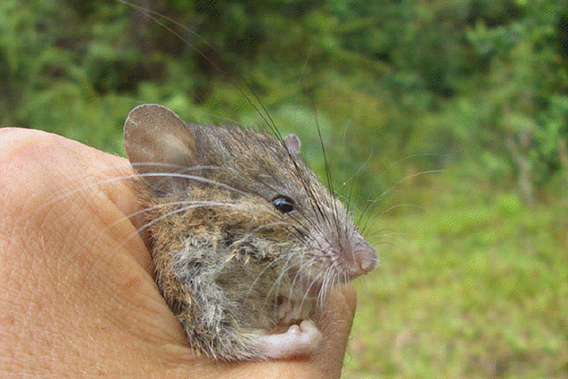 Christine’s Margareta rat. Photo by: Alessio Mortelliti/Sapienza University. Researchers have discovered a new species of rodent in Indonesia’s Mekongga Mountains, reports the Jakarta Globe. The new rodent, Christine’s Margareta rat (Margaretamys christinae), is only the fourth in the genus Margaretamy, all of which are found on the island of Sulawesi. The new mammal’s discoverer, Alessio […]
Christine’s Margareta rat. Photo by: Alessio Mortelliti/Sapienza University. Researchers have discovered a new species of rodent in Indonesia’s Mekongga Mountains, reports the Jakarta Globe. The new rodent, Christine’s Margareta rat (Margaretamys christinae), is only the fourth in the genus Margaretamy, all of which are found on the island of Sulawesi. The new mammal’s discoverer, Alessio […]
First snow leopards collared in Afghanistan as species faces rising threat from climate change
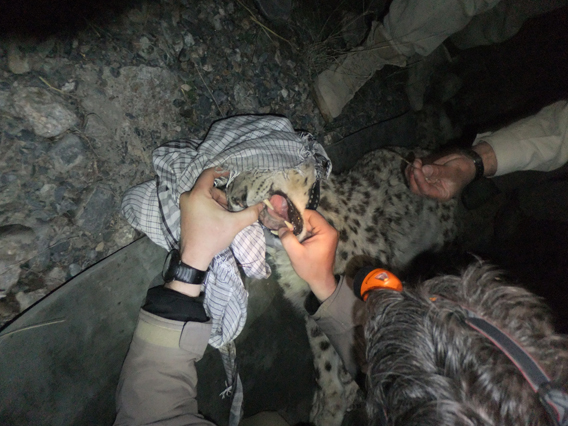 The research team conducts a dental exam of a snow leopard prior to its release. Photo by: Anthony Simms/WCS. Scientists have captured and collared two snow leopards (Panthera uncia), arguably one of the world’s most elusive predators, in Afghanistan for the first time. Undertaken by researchers with Wildlife Conservation Society (WCS) and Afghani vets, the […]
The research team conducts a dental exam of a snow leopard prior to its release. Photo by: Anthony Simms/WCS. Scientists have captured and collared two snow leopards (Panthera uncia), arguably one of the world’s most elusive predators, in Afghanistan for the first time. Undertaken by researchers with Wildlife Conservation Society (WCS) and Afghani vets, the […]
Google Earth used to discover unknown forest in Angola, scientists find it full of rare birds
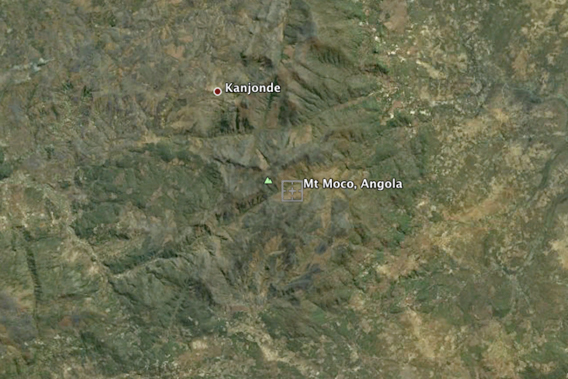 The forests of Mount Moco were once considered the largest montane forests left in Angola, until researchers discovered more forsts in the Namba Mountains. Photo courtesy of Google Earth. An expedition, followed up by some computer hunting on Google Earth, has discovered large remnants of old growth forest, including thriving bird communities, in the mountains […]
The forests of Mount Moco were once considered the largest montane forests left in Angola, until researchers discovered more forsts in the Namba Mountains. Photo courtesy of Google Earth. An expedition, followed up by some computer hunting on Google Earth, has discovered large remnants of old growth forest, including thriving bird communities, in the mountains […]
Exploring Asia’s lost world
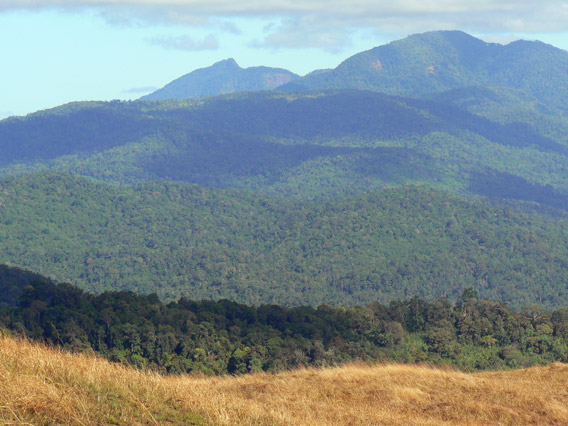 Abandoned by conservationists and the global community, Virachey National Park in Cambodia remains a wildernesses of surprises. An interview with Greg McCann. Haling-Halang and the barrier mountains separating Cambodia and Laos as seen from the Veal Thom grasslands, a place few outsiders have ever seen. Could tigers, Javan rhinos, or saola live in these mountains? […]
Abandoned by conservationists and the global community, Virachey National Park in Cambodia remains a wildernesses of surprises. An interview with Greg McCann. Haling-Halang and the barrier mountains separating Cambodia and Laos as seen from the Veal Thom grasslands, a place few outsiders have ever seen. Could tigers, Javan rhinos, or saola live in these mountains? […]
Cloud forests may be particularly vulnerable to climate change
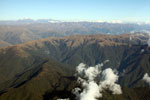 View Larger MapSierra de Juárez in Oaxaca is one of the most important cloud forests in Mexico, but remains unprotected. Mexico could lose nearly 70 percent of its cloud forests due to climate change by 2080, according to new research published in Nature Climate Change, that has implications for cloud forests worldwide. “Given the narrow […]
View Larger MapSierra de Juárez in Oaxaca is one of the most important cloud forests in Mexico, but remains unprotected. Mexico could lose nearly 70 percent of its cloud forests due to climate change by 2080, according to new research published in Nature Climate Change, that has implications for cloud forests worldwide. “Given the narrow […]
Interactive map reveals the human cost of mountaintop mining
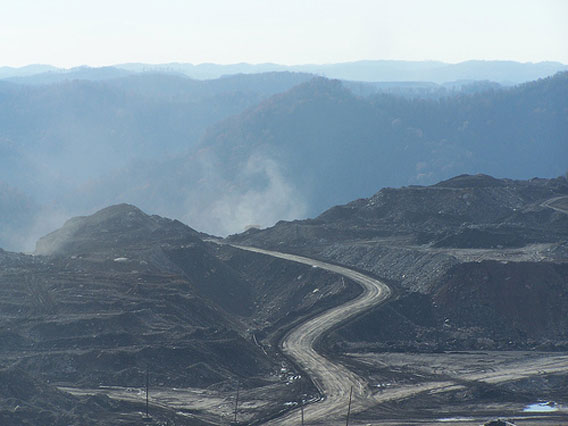 Mountain top removal mining site. Photo by: JW Randolph. Environmental degradation can have major impacts on a community’s quality of life and a new interactive map of mountaintop mining for coal in the U.S. makes this abundantly clear: based on 21 scientific studies, the map highlights how communities near mountaintop mining have lower life expectancy, […]
Mountain top removal mining site. Photo by: JW Randolph. Environmental degradation can have major impacts on a community’s quality of life and a new interactive map of mountaintop mining for coal in the U.S. makes this abundantly clear: based on 21 scientific studies, the map highlights how communities near mountaintop mining have lower life expectancy, […]
Photo: new blue, red, yellow lizard discovered in the Andes
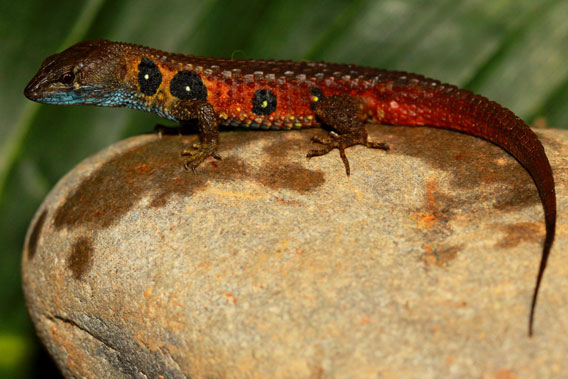 A male Potamites montanicola, a new species of lizard discovered in the Peruvian Andes. Photo courtesy of German Chávez. Researchers have discovered a new species of lizard in the Peruvian Andes, whose males sport beautiful colors, according to a paper in ZooKeys. The highest-dwelling known species of the genus Potamites, the new lizard, dubbed Potamites […]
A male Potamites montanicola, a new species of lizard discovered in the Peruvian Andes. Photo courtesy of German Chávez. Researchers have discovered a new species of lizard in the Peruvian Andes, whose males sport beautiful colors, according to a paper in ZooKeys. The highest-dwelling known species of the genus Potamites, the new lizard, dubbed Potamites […]
Majority of Andes’ biodiversity hotspots remain unprotected
 Amazon cloud forest and the Andes in Peru. This region of the world may be home to more endemic species than any other. Photo by: Rhett A. Butler. Around 80 percent of the Andes’ most biodiverse and important ecosystems are unprotected according to a new paper published in the open-access journal BMC Ecology. Looking at […]
Amazon cloud forest and the Andes in Peru. This region of the world may be home to more endemic species than any other. Photo by: Rhett A. Butler. Around 80 percent of the Andes’ most biodiverse and important ecosystems are unprotected according to a new paper published in the open-access journal BMC Ecology. Looking at […]
Geology has split the Amazon into two distinct forests
 Aerial photo of an Amazon rainforest tributary in Peru. Photo by: Rhett A. Butler. The common view of the Amazon is that it is one massive, unbroken forest. This impression is given by maps which tend to mark the Amazon by a large glob of green or even by its single name which doesn’t account […]
Aerial photo of an Amazon rainforest tributary in Peru. Photo by: Rhett A. Butler. The common view of the Amazon is that it is one massive, unbroken forest. This impression is given by maps which tend to mark the Amazon by a large glob of green or even by its single name which doesn’t account […]
Conserving Ecuador’s Paramos, the alpine tundra ecosystem of the Andes
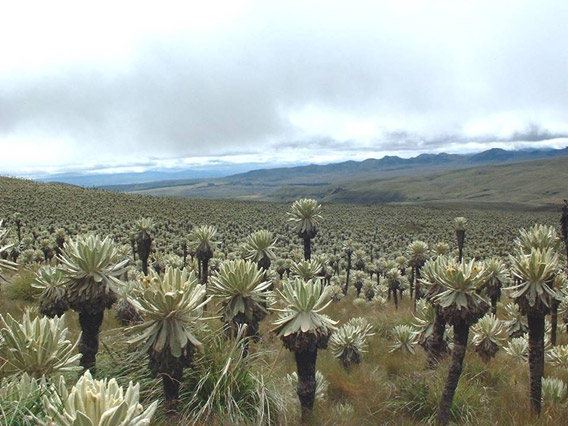 Páramo: Paisaje estudiado, habitado, manejado e institucionalizado á Pramo – an Ecuador overview Páramos © Robert Hofstede. Grupo de Trabajo en Páramos del Ecuador (GTP) is a remarkable self-organized group of páramo experts that have met over the past 13 years in Quito, Ecuador. Páramo is an alpine tundra ecosystem which is located in the […]
Páramo: Paisaje estudiado, habitado, manejado e institucionalizado á Pramo – an Ecuador overview Páramos © Robert Hofstede. Grupo de Trabajo en Páramos del Ecuador (GTP) is a remarkable self-organized group of páramo experts that have met over the past 13 years in Quito, Ecuador. Páramo is an alpine tundra ecosystem which is located in the […]
Borneo’s most elusive feline photographed at unexpected elevation
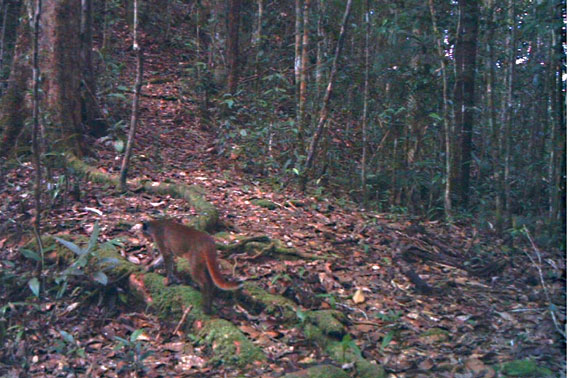 The elusive bay cat, taken by motion-triggered camera-trap in the Kelabit Highlands of Sarawak, Malaysian Borneo. Copyright: J. Brodie & A. Giordano. Although known to science for 138 years, almost nothing is actually known about the bay cat (Pardofelis badia). This reddish-brown wild feline, endemic to the island of Borneo, has entirely eluded researchers and […]
The elusive bay cat, taken by motion-triggered camera-trap in the Kelabit Highlands of Sarawak, Malaysian Borneo. Copyright: J. Brodie & A. Giordano. Although known to science for 138 years, almost nothing is actually known about the bay cat (Pardofelis badia). This reddish-brown wild feline, endemic to the island of Borneo, has entirely eluded researchers and […]
Seals, birds, and alpine plants suffer under climate change
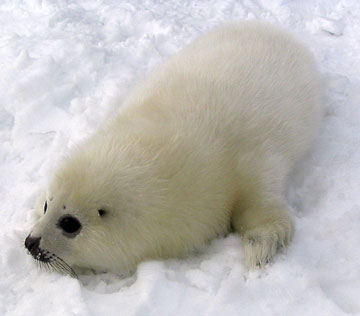 The number of species identified by scientists as vulnerable to climate change continues to rise along with the Earth’s temperature. Recent studies have found that a warmer world is leading to premature deaths of harp seal pups (Pagophilus groenlandicus) in the Arctic, a decline of some duck species in Canada, shrinking alpine meadows in Europe, […]
The number of species identified by scientists as vulnerable to climate change continues to rise along with the Earth’s temperature. Recent studies have found that a warmer world is leading to premature deaths of harp seal pups (Pagophilus groenlandicus) in the Arctic, a decline of some duck species in Canada, shrinking alpine meadows in Europe, […]
Photos: two new paper clip-sized frogs discovered in Vietnamese mountains
 New species of frog: the cloaked moss frog (Theloderma palliatum). Photo by: Jodi J. L. Rowley/Australian Museum. Researchers have discovered two new frog species living in the montane tropical forests of Vietnam. Known as moss frogs, these small amphibians employ camouflage as one way to keep predators at bay, in some cases resembling the moss […]
New species of frog: the cloaked moss frog (Theloderma palliatum). Photo by: Jodi J. L. Rowley/Australian Museum. Researchers have discovered two new frog species living in the montane tropical forests of Vietnam. Known as moss frogs, these small amphibians employ camouflage as one way to keep predators at bay, in some cases resembling the moss […]
Volcano and cloud forests conserved in Ecuador
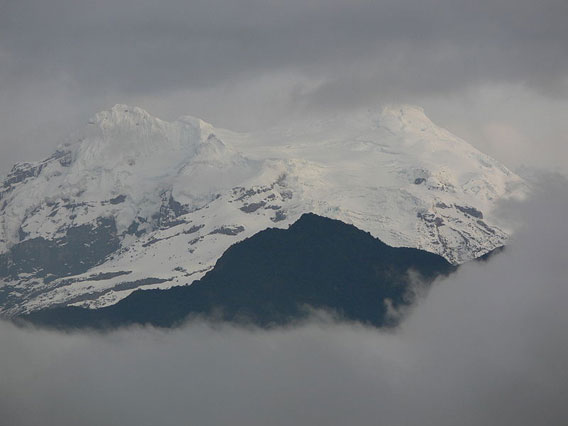 Antisana Volcano. Photo by: Stefan Weigal. Conservation organizations and the Ecuadorian government have succeeded in securing over 250,000 acres (106,000 hectares) of cloud forest and grasslands surrounding the Antisana Volcano for protection. The area, long-used for cattle ranching, is home to Andean condors (Vultur gryphus), cougars (Puma concolor), Andean fox (Lycalopex culpaeus), silvery grebes (Podiceps […]
Antisana Volcano. Photo by: Stefan Weigal. Conservation organizations and the Ecuadorian government have succeeded in securing over 250,000 acres (106,000 hectares) of cloud forest and grasslands surrounding the Antisana Volcano for protection. The area, long-used for cattle ranching, is home to Andean condors (Vultur gryphus), cougars (Puma concolor), Andean fox (Lycalopex culpaeus), silvery grebes (Podiceps […]
Wolverines live up to tough reputation
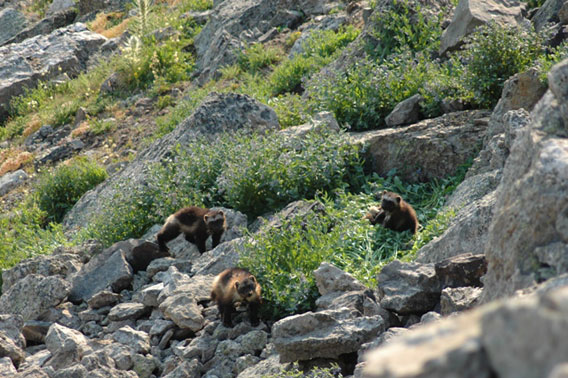 A mother and wolverine cubs photographed in the Greater Yellowstone Ecosystem. Photo by: Mark Packila/Wildlife Conservation Society (WCS). In the first X-Men film, the comic book character Wolverine is asked if it hurts when his claws retract from his knuckles. His unflinching response: “Every time.” The real wolverine (Gulo gulo) is just as tenacious with […]
A mother and wolverine cubs photographed in the Greater Yellowstone Ecosystem. Photo by: Mark Packila/Wildlife Conservation Society (WCS). In the first X-Men film, the comic book character Wolverine is asked if it hurts when his claws retract from his knuckles. His unflinching response: “Every time.” The real wolverine (Gulo gulo) is just as tenacious with […]
800 nearly-extinct giant snails freeze to death in conservation center
 New Zealand’s Powelliphanta snail. Photo by: Alan Liefting. Eight hundred large carnivorous snails, known as Powelliphanta snails (Powelliphanta augusta), died in a Department of Conservation (DOC) fridge in New Zealand over the weekend. A faulty temperature gauge caused the fridge to cool down to zero degrees Celsius, slowly killing all the molluscs but a lone […]
New Zealand’s Powelliphanta snail. Photo by: Alan Liefting. Eight hundred large carnivorous snails, known as Powelliphanta snails (Powelliphanta augusta), died in a Department of Conservation (DOC) fridge in New Zealand over the weekend. A faulty temperature gauge caused the fridge to cool down to zero degrees Celsius, slowly killing all the molluscs but a lone […]
Featured video: camera traps catch Andean cats and others in Argentina
Camera traps set up in the Jujuy Province of Argentina have captured rare images of the elusive and playful Andean cat and Pampas cat, along with other South American wildlife, including vizcachas, culpeo foxes, and skunks. Before 1998, there were only two photos of a wild Andean cats, today conservation attention along with camera traps […]
Viable population of snow leopards still roam Afghanistan (pictures)
.568.jpg) Snow leopard in the Wakhan Corridor caught on camera trap. Photo by: Wildlife Conservation Society. Decades of war and poverty has not exterminated snow leopards (Panthera uncia) in Afghanistan according to a new paper in the International Journal of Environmental Studies, written by researchers with the Wildlife Conservation Society (WCS). Instead the researchers report a […]
Snow leopard in the Wakhan Corridor caught on camera trap. Photo by: Wildlife Conservation Society. Decades of war and poverty has not exterminated snow leopards (Panthera uncia) in Afghanistan according to a new paper in the International Journal of Environmental Studies, written by researchers with the Wildlife Conservation Society (WCS). Instead the researchers report a […]
South Sudan’s tropical forests fast disappearing
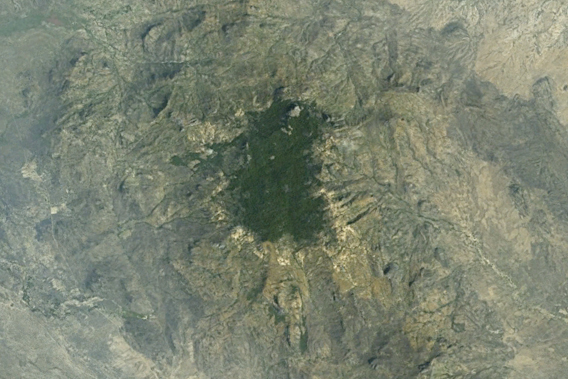 Forest loss along the edge of Mount Dongotomea in South Sudan is visible from Google Earth. South Sudan’s tropical montane forests are fast disappearing according to new analysis by PRINS Engineering. At current rates, Mount Dongotomea, located in South Sudan’s most biodiverse ecosystem, could be completely stripped of tree cover by 2020. The forests of […]
Forest loss along the edge of Mount Dongotomea in South Sudan is visible from Google Earth. South Sudan’s tropical montane forests are fast disappearing according to new analysis by PRINS Engineering. At current rates, Mount Dongotomea, located in South Sudan’s most biodiverse ecosystem, could be completely stripped of tree cover by 2020. The forests of […]
Red rodent shows up at Colombian nature lodge after 113 years on the lam
-ProAves-2.main.568.jpg) Not seen for over a century, these are the first ever photos of a living red-crested tree rat. Photo by: Lizzie Noble/ProAves. The red-crested tree rat (Santamartamys rufodorsalis) had not been recorded since 1898 and was thought possibly extinct—that is until one showed up at 9:30 PM on May 4th at a lodge in El […]
Not seen for over a century, these are the first ever photos of a living red-crested tree rat. Photo by: Lizzie Noble/ProAves. The red-crested tree rat (Santamartamys rufodorsalis) had not been recorded since 1898 and was thought possibly extinct—that is until one showed up at 9:30 PM on May 4th at a lodge in El […]
No limbs or sight needed: bizarre new lizard uncovered in Cambodia
 The newly discovered Dalai Mountain blind lizard (Dibamus dalaiensis). Photo courtesy of Fauna & Flora International. A new species of legless lizard has been discovered in Cambodia. Herpetologist Neang Thy uncovered, literally, the new species when he turned over a log in the species-rich Cardamom Mountains. While the new lizard looks like a snake or […]
The newly discovered Dalai Mountain blind lizard (Dibamus dalaiensis). Photo courtesy of Fauna & Flora International. A new species of legless lizard has been discovered in Cambodia. Herpetologist Neang Thy uncovered, literally, the new species when he turned over a log in the species-rich Cardamom Mountains. While the new lizard looks like a snake or […]
Conservation organizations ask Tanzania to reconsider UNESCO status for Eastern Arc Mountains
 Tanzanian President Jakaya Kikwete has recently stated he would withdraw the application to list two Eastern Arc Mountains as UNESCO World Heritage sites: Udzungwa and Uluguru Mountains. However, ten NGOS, both local and international, have asked the president to reconsider, according to The Citizen. President Kikwete had said the withdrawal was necessary because the mountains […]
Tanzanian President Jakaya Kikwete has recently stated he would withdraw the application to list two Eastern Arc Mountains as UNESCO World Heritage sites: Udzungwa and Uluguru Mountains. However, ten NGOS, both local and international, have asked the president to reconsider, according to The Citizen. President Kikwete had said the withdrawal was necessary because the mountains […]
Warmer temperatures may be exterminating pika populations one-by-one
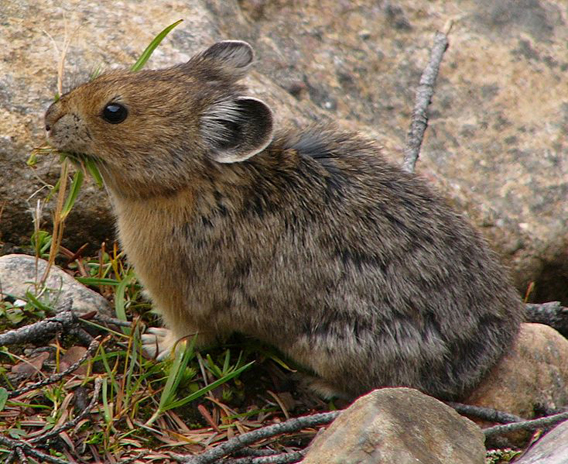 An American pika (Ochotona princeps) in Colorado. Photo in Public Domain. The last decade has not been a good one for the American pika (Ochotona princeps) according to a new study in Global Change Biology. Over the past ten years extinction rates have increased by nearly five times for pika populations in the Great Basin […]
An American pika (Ochotona princeps) in Colorado. Photo in Public Domain. The last decade has not been a good one for the American pika (Ochotona princeps) according to a new study in Global Change Biology. Over the past ten years extinction rates have increased by nearly five times for pika populations in the Great Basin […]
From the Serengeti to Lake Natron: is the Tanzanian government aiming to destroy its wildlife and lands?
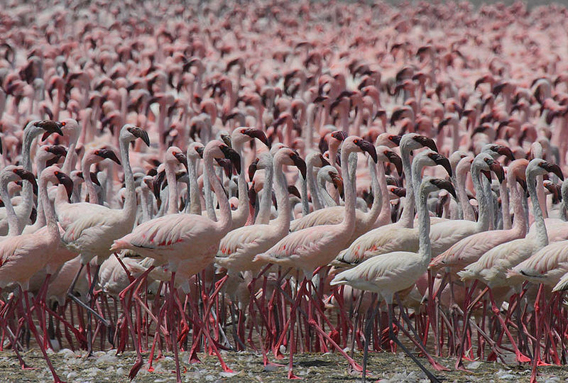 Thousands of lesser flamingoes (Phoenicopterus minor) crowd in Lake Bogoria in Kenya. Nearly all of these flamingoes will breed in Tanzania’s Lake Natron, now a proposed site for soda ash mining. Photo by: Steve Garvie. What’s happening in Tanzania? This is a question making the rounds in conservation and environmental circles. Why is a nation […]
Thousands of lesser flamingoes (Phoenicopterus minor) crowd in Lake Bogoria in Kenya. Nearly all of these flamingoes will breed in Tanzania’s Lake Natron, now a proposed site for soda ash mining. Photo by: Steve Garvie. What’s happening in Tanzania? This is a question making the rounds in conservation and environmental circles. Why is a nation […]
Amazon still neglected by researchers
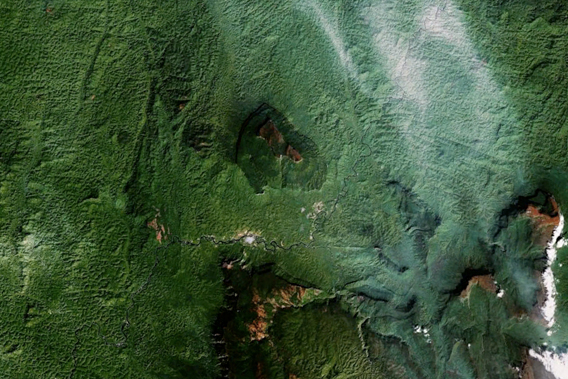 Terra Incognito? Venezuela’s Amazon rainforest (a portion of which is viewed here by Google Earth) has been almost wholly ignored by researchers. Andean forests even less represented in research than the Amazon. Although the Amazon is the world’s largest tropical forest, it is not the most well known. Given the difficulty of access along with […]
Terra Incognito? Venezuela’s Amazon rainforest (a portion of which is viewed here by Google Earth) has been almost wholly ignored by researchers. Andean forests even less represented in research than the Amazon. Although the Amazon is the world’s largest tropical forest, it is not the most well known. Given the difficulty of access along with […]
New population discovered of the America’s mini snow leopard: the Andean cat
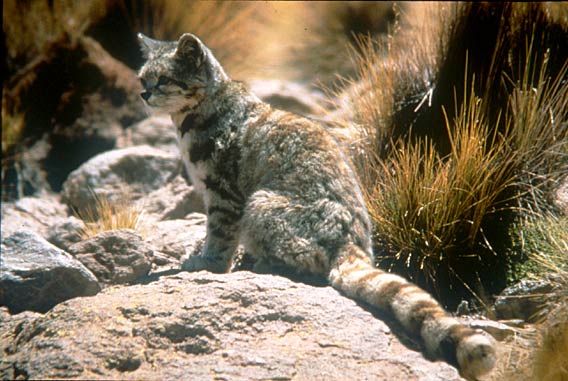 The Andean cat. © Jim Sanderson, PhD/Small Wild Cat Conservation Foundation. The elusive Andean cat (Leopardus jacobita), which until the late 1990s was only known to scientists by a couple photographs, has been discovered beyond the Andes mountain range for which it is named. According to researchers, the wild Andean cat resembles Asia’s snow leopard, […]
The Andean cat. © Jim Sanderson, PhD/Small Wild Cat Conservation Foundation. The elusive Andean cat (Leopardus jacobita), which until the late 1990s was only known to scientists by a couple photographs, has been discovered beyond the Andes mountain range for which it is named. According to researchers, the wild Andean cat resembles Asia’s snow leopard, […]
New population of Critically Endangered monkey discovered
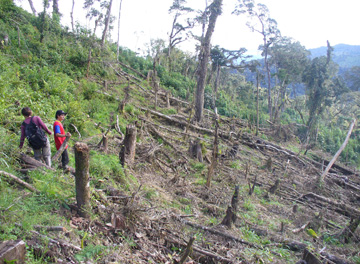 Classified as Critically Endangered by the IUCN Red List, listed among the Top 25 Most Endangered primates in the world, and rated number 71 on the EDGE’s list of world’s most endangered and unique mammals, the yellow-tailed woolly monkey needed some good news—and this week it got it. The conservation organization, Neotropical Primate Conservation (NPC), […]
Classified as Critically Endangered by the IUCN Red List, listed among the Top 25 Most Endangered primates in the world, and rated number 71 on the EDGE’s list of world’s most endangered and unique mammals, the yellow-tailed woolly monkey needed some good news—and this week it got it. The conservation organization, Neotropical Primate Conservation (NPC), […]
Photographer discovers new species of meat-eating plant in Cambodia
 British photographer Jeremy Holden recently discovered a new species of carnivorous pitcher plant in Cambodia’s Cardamom Mountains during a survey with Fauna & Flora International (FFI). “The Cardamom Mountains are a treasure chest of new species, but it was a surprise to find something as exciting and charismatic as an unknown pitcher plant,” Holden said […]
British photographer Jeremy Holden recently discovered a new species of carnivorous pitcher plant in Cambodia’s Cardamom Mountains during a survey with Fauna & Flora International (FFI). “The Cardamom Mountains are a treasure chest of new species, but it was a surprise to find something as exciting and charismatic as an unknown pitcher plant,” Holden said […]
Photos: 200 new species discovered in 60-day expedition in New Guinea
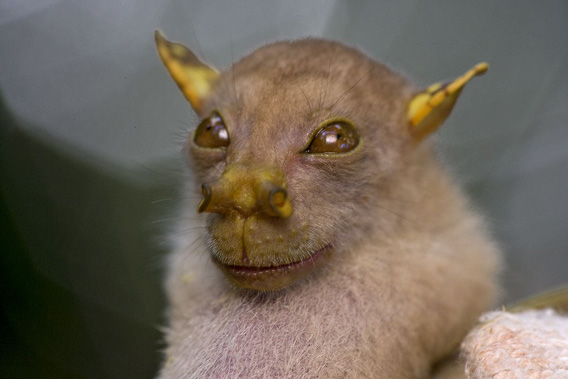 This fruit bat has been seen prior to this expedition, but remains undescribed. Although scientists have yet to name the species, the popular media has already dubbed it the ‘Yoda bat’ given its resemblance to the Jedi master character from the Star Wars series. Fruit bats are vital to rainforests as they disperse seeds. Photo […]
This fruit bat has been seen prior to this expedition, but remains undescribed. Although scientists have yet to name the species, the popular media has already dubbed it the ‘Yoda bat’ given its resemblance to the Jedi master character from the Star Wars series. Fruit bats are vital to rainforests as they disperse seeds. Photo […]
Tigers discovered living on the roof of the world
A BBC film crew has photographed Bengal tigers, including a mating pair, living far higher than the great cats have been documented before. Camera traps captured images and videos of tigers living 4,000 meters (over 13,000 feet) in the tiny Himalayan nation of Bhutan. The discovery is particularly surprising as most tigers inhabit forests, where […]
Exploring Kenya’s sky island
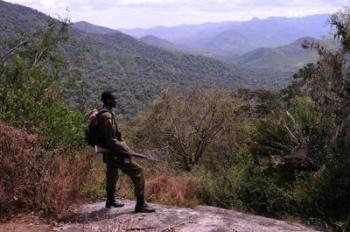 An interview with Paula Kahumbu of WildlifeDirect. Rising over 2,500 meters from Kenya’s northern desert, the Mathews Range is a sky island: isolated mountain forests surrounded by valleys. Long cut off from other forests, ‘sky islands’ such as this often contain unique species and ecosystems. Supported by the Nature Conservancy, an expedition including local community […]
An interview with Paula Kahumbu of WildlifeDirect. Rising over 2,500 meters from Kenya’s northern desert, the Mathews Range is a sky island: isolated mountain forests surrounded by valleys. Long cut off from other forests, ‘sky islands’ such as this often contain unique species and ecosystems. Supported by the Nature Conservancy, an expedition including local community […]
Feeds: news | india | latam | brasil | indonesia
 A sage grouse struts his stuff. Photo credit: Tom Koerner/USFWS. We try to walk quietly on a path that’s barely lit by a waning moon and the night’s last stars, speaking in hushed whispers as we trip over sagebrush and pant in the thin air. It’s spring, and we‘re trekking across high prairie ranchland in […]
A sage grouse struts his stuff. Photo credit: Tom Koerner/USFWS. We try to walk quietly on a path that’s barely lit by a waning moon and the night’s last stars, speaking in hushed whispers as we trip over sagebrush and pant in the thin air. It’s spring, and we‘re trekking across high prairie ranchland in […] Sierra Nevada fox caught on camera trap in Yosemite National Park. Photo by: National Park Service. For years, biologists believed the Sierra Nevada fox (Vulpes vulpes necator) was down to a single population of around 20 animals in California’s Lassen Volcanic National Park. But then in 2010, biologists found a small population near Sonora Pass. […]
Sierra Nevada fox caught on camera trap in Yosemite National Park. Photo by: National Park Service. For years, biologists believed the Sierra Nevada fox (Vulpes vulpes necator) was down to a single population of around 20 animals in California’s Lassen Volcanic National Park. But then in 2010, biologists found a small population near Sonora Pass. […] Tracking lions, photographing bats, collecting insects, bringing elephants home: it’s all part of a day’s work in Gorongosa National Park. This vast wilderness in Mozambique—including savannah and montane rainforest—was ravaged by civil war in the 1980s and 90s. However, a unique and ambitious 20-year-effort spearheaded by Greg Carr through the Gorongosa Restoration Project—and partnering with […]
Tracking lions, photographing bats, collecting insects, bringing elephants home: it’s all part of a day’s work in Gorongosa National Park. This vast wilderness in Mozambique—including savannah and montane rainforest—was ravaged by civil war in the 1980s and 90s. However, a unique and ambitious 20-year-effort spearheaded by Greg Carr through the Gorongosa Restoration Project—and partnering with […] This potentially new lizard species was discovered on the last day of a survey in a cloud forest in Andean Peru. Photo: Luis Mamani. A group of Peruvian and Mexican scientists say they have uncovered at least six new species near South America’s most famous archaeological site: Machu Picchu. The discoveries include a new mammal, […]
This potentially new lizard species was discovered on the last day of a survey in a cloud forest in Andean Peru. Photo: Luis Mamani. A group of Peruvian and Mexican scientists say they have uncovered at least six new species near South America’s most famous archaeological site: Machu Picchu. The discoveries include a new mammal, […] Rediscovered mammal had been slaughtered by the Inca hundreds of years ago The Machu Picchu arboreal chinchilla rat come back to life! Photo by: Roberto Quispe. Below one of the most famous archaeological sites in the world, scientists have made a remarkable discovery: a living cat-sized mammal that, until now, was only known from bones. […]
Rediscovered mammal had been slaughtered by the Inca hundreds of years ago The Machu Picchu arboreal chinchilla rat come back to life! Photo by: Roberto Quispe. Below one of the most famous archaeological sites in the world, scientists have made a remarkable discovery: a living cat-sized mammal that, until now, was only known from bones. […] The Perijá brush-finch has only recently been considered a species in its own right. Photo by: Trevor Ellery. A coalition of conservation groups have established a new protected area in one of Latin America’s most neglected ecosystems: the Colombian-side of the Serranía de Perijá mountain range. Following decades of bloody conflict and rampant deforestation, experts […]
The Perijá brush-finch has only recently been considered a species in its own right. Photo by: Trevor Ellery. A coalition of conservation groups have established a new protected area in one of Latin America’s most neglected ecosystems: the Colombian-side of the Serranía de Perijá mountain range. Following decades of bloody conflict and rampant deforestation, experts […] It’s not easy to measure carbon in mountain forest ecosystems. For one thing, climbing into these forests can be difficult, exhausting, and even treacherous. For another, many mountain rainforests are almost constantly blanketed by clouds—hence the term “cloud forest”—making it problematic to measure above-ground carbon storage from the air or satellite. But a new review […]
It’s not easy to measure carbon in mountain forest ecosystems. For one thing, climbing into these forests can be difficult, exhausting, and even treacherous. For another, many mountain rainforests are almost constantly blanketed by clouds—hence the term “cloud forest”—making it problematic to measure above-ground carbon storage from the air or satellite. But a new review […] Overall, the brown bear is one of the most widespread bear species in the world, found in much of Eurasia and North America, in quite large numbers. A subspecies called the Himalayan brown bear is not so fortunate. It occupies higher reaches of the Himalayas in remote, mountainous areas of Pakistan, Nepal, Tibet and India. […]
Overall, the brown bear is one of the most widespread bear species in the world, found in much of Eurasia and North America, in quite large numbers. A subspecies called the Himalayan brown bear is not so fortunate. It occupies higher reaches of the Himalayas in remote, mountainous areas of Pakistan, Nepal, Tibet and India. […] Forestry authorities in China have stopped commercial logging in the nation’s largest forest area, marking an end to more than a half-century of intensive deforestation that removed an estimated 600 million cubic meters (21 billion cubic feet) of timber. The logging shutdown was enacted in large part to protect soil and water quality of greater […]
Forestry authorities in China have stopped commercial logging in the nation’s largest forest area, marking an end to more than a half-century of intensive deforestation that removed an estimated 600 million cubic meters (21 billion cubic feet) of timber. The logging shutdown was enacted in large part to protect soil and water quality of greater […] What do mountains have to do with climate change? More than you’d expect: new research shows that the weathering rates of mountains caused by vegetation growth plays a major role in controlling global temperatures. Scientists from the University of Oxford and the University of Sheffield have shown how tree roots in certain mountains “acted like […]
What do mountains have to do with climate change? More than you’d expect: new research shows that the weathering rates of mountains caused by vegetation growth plays a major role in controlling global temperatures. Scientists from the University of Oxford and the University of Sheffield have shown how tree roots in certain mountains “acted like […] Malaria is a global scourge: despite centuries of efforts to combat the mosquito-borne disease, it still kills between 660,000 to 1.2 million people a year, according to World Health Organization data from 2010. Astoundingly, experts estimate that around 300 million people are infected with the disease every year or about 4 percent of the world’s […]
Malaria is a global scourge: despite centuries of efforts to combat the mosquito-borne disease, it still kills between 660,000 to 1.2 million people a year, according to World Health Organization data from 2010. Astoundingly, experts estimate that around 300 million people are infected with the disease every year or about 4 percent of the world’s […] On a Friday afternoon in June, the Plaza de Armas in Cajamarca is pulsing with life. It’s winter here, and although thick white clouds hover low in the distance, the sun in this northern Peruvian city is warm. Couples sit on benches facing one another. Kids run in the grass between flowerbeds. Men in suits […]
On a Friday afternoon in June, the Plaza de Armas in Cajamarca is pulsing with life. It’s winter here, and although thick white clouds hover low in the distance, the sun in this northern Peruvian city is warm. Couples sit on benches facing one another. Kids run in the grass between flowerbeds. Men in suits […] Scientists knew that snow leopards (Panthera uncia) still survived in the Central Asian country of Uzbekistan, but late last year they captured the first ever photos. Camera traps in the Gissar Nature Reserve took photos of the big cats, along with bear, lynx, ibex, wild boar, and other mammals. The camera trap program was led […]
Scientists knew that snow leopards (Panthera uncia) still survived in the Central Asian country of Uzbekistan, but late last year they captured the first ever photos. Camera traps in the Gissar Nature Reserve took photos of the big cats, along with bear, lynx, ibex, wild boar, and other mammals. The camera trap program was led […] The purported Yeti, an ape-like creature that walks upright and roams the remote Himalayas, may in fact be an ancient polar bear species, according to new DNA research by Bryan Sykes with Oxford University. Sykes subjected two hairs from what locals say belonged to the elusive Yeti only to discover that the genetics matched a […]
The purported Yeti, an ape-like creature that walks upright and roams the remote Himalayas, may in fact be an ancient polar bear species, according to new DNA research by Bryan Sykes with Oxford University. Sykes subjected two hairs from what locals say belonged to the elusive Yeti only to discover that the genetics matched a […] Last month scientists unveiled a remarkable discovery: a new mammal in the order Carnivora (even though it mostly lives off fruits) in the Andean cloud forests. This was the first new mammal from that order in the Western Hemisphere since the 1970s. The olinguito had long been mistaken for its closest relatives, olingos—small tree-dwelling mammals […]
Last month scientists unveiled a remarkable discovery: a new mammal in the order Carnivora (even though it mostly lives off fruits) in the Andean cloud forests. This was the first new mammal from that order in the Western Hemisphere since the 1970s. The olinguito had long been mistaken for its closest relatives, olingos—small tree-dwelling mammals […] Teddy bear-like carnivorous creature discovered in South America (photos) While the olinguito looks like a wild, tree-climbing teddy bear with a cat’s tail, it’s actually the world’s newest mammalian carnivore. The remarkable discovery—the first mammal carnivore uncovered in the Western Hemisphere since the 1970s—was found in the lush cloud forests of the Andes, a biodiverse […]
Teddy bear-like carnivorous creature discovered in South America (photos) While the olinguito looks like a wild, tree-climbing teddy bear with a cat’s tail, it’s actually the world’s newest mammalian carnivore. The remarkable discovery—the first mammal carnivore uncovered in the Western Hemisphere since the 1970s—was found in the lush cloud forests of the Andes, a biodiverse […] The 2013 Zoos and Aquariums: Committing to Conservation (ZACC) conference runs from July 8th—July 12th in Des Moines, Iowa, hosted by the Blank Park Zoo. Ahead of the event, Mongabay.com is running a series of Q&As with presenters. For more interviews, please see our ZACC feed. Snow leopard. Photo by: Steve Winter/National Geographic. Tibetan monks […]
The 2013 Zoos and Aquariums: Committing to Conservation (ZACC) conference runs from July 8th—July 12th in Des Moines, Iowa, hosted by the Blank Park Zoo. Ahead of the event, Mongabay.com is running a series of Q&As with presenters. For more interviews, please see our ZACC feed. Snow leopard. Photo by: Steve Winter/National Geographic. Tibetan monks […] If you fly over the Great African Rift Valley from its northernmost point in Ethiopia, over the great national parks of Kenya and Tanzania, and follow it south to the very end, you will arrive at Gorongosa National Park in central Mozambique. Plateaus on the eastern and western sides of the park flank the lush […]
If you fly over the Great African Rift Valley from its northernmost point in Ethiopia, over the great national parks of Kenya and Tanzania, and follow it south to the very end, you will arrive at Gorongosa National Park in central Mozambique. Plateaus on the eastern and western sides of the park flank the lush […] Scientists have uncovered two miniature spiders living on mountains in China’s southern region, one of which is among the smallest spiders recorded worldwide, according to a new paper in ZooKeys. Both spiders belong to the Mysmenidae family, which is made up of mini-spiders with eight eyes. “Although the family Mysmenidae is distributed worldwide, it is […]
Scientists have uncovered two miniature spiders living on mountains in China’s southern region, one of which is among the smallest spiders recorded worldwide, according to a new paper in ZooKeys. Both spiders belong to the Mysmenidae family, which is made up of mini-spiders with eight eyes. “Although the family Mysmenidae is distributed worldwide, it is […] Glaciers in the Mount Everest region have shrunk by 13 percent and the snow-line has shifted 180 meters (590 feet) higher during the past 50 years, according to a study that will be presented this week at a conference organized by the American Geophysical Union. The research, led by Sudeep Thakuri of the University of […]
Glaciers in the Mount Everest region have shrunk by 13 percent and the snow-line has shifted 180 meters (590 feet) higher during the past 50 years, according to a study that will be presented this week at a conference organized by the American Geophysical Union. The research, led by Sudeep Thakuri of the University of […] Wolverine in the snow. Photo by: Bigstock. Arguably one of the toughest animals on Earth, the wolverine (Gulo gulo) may soon find itself protected under the U.S.’s Endangered Species Act (ESA) as climate change melts away its preferred habitat. Last week, the U.S. Fish and Wildlife Service (FWS) announced it was proposing to place the […]
Wolverine in the snow. Photo by: Bigstock. Arguably one of the toughest animals on Earth, the wolverine (Gulo gulo) may soon find itself protected under the U.S.’s Endangered Species Act (ESA) as climate change melts away its preferred habitat. Last week, the U.S. Fish and Wildlife Service (FWS) announced it was proposing to place the […] Pastoruri Glacier. Photo by: Edubucher/Wikimedia Commons. Glaciers are melting faster than ever in the tropical Andes, warns a new study published in The Cryosphere, which puts the blame for vanishing glaciers squarely on climate change. The study — the most comprehensive to date — found that since the 1970s glacier melt in the region has […]
Pastoruri Glacier. Photo by: Edubucher/Wikimedia Commons. Glaciers are melting faster than ever in the tropical Andes, warns a new study published in The Cryosphere, which puts the blame for vanishing glaciers squarely on climate change. The study — the most comprehensive to date — found that since the 1970s glacier melt in the region has […] Wild yaks cross the Tibetan Plateau near the edge of a glacier. A scientific team recently counted more than a thousand wild yaks in this region signaling a possible comeback for this species once decimated by over-hunting. Photo by: Joel Berger, WCS/University of Montana. Unlike Asia’s largest animal (the elephant) and its second largest (the […]
Wild yaks cross the Tibetan Plateau near the edge of a glacier. A scientific team recently counted more than a thousand wild yaks in this region signaling a possible comeback for this species once decimated by over-hunting. Photo by: Joel Berger, WCS/University of Montana. Unlike Asia’s largest animal (the elephant) and its second largest (the […] Whitebark pine stand. Photo by: Richard Sniezko/U.S. Forest Service. In the western U.S., few trees generally grow in higher altitudes than the whitebark pine (Pinus albicaulis). Providing shelter and food for bears, squirrels and birds, the whitebark pine ecosystems also help regulate water flow from snowmelt. But, according to a new study in the Proceedings […]
Whitebark pine stand. Photo by: Richard Sniezko/U.S. Forest Service. In the western U.S., few trees generally grow in higher altitudes than the whitebark pine (Pinus albicaulis). Providing shelter and food for bears, squirrels and birds, the whitebark pine ecosystems also help regulate water flow from snowmelt. But, according to a new study in the Proceedings […] Gaysay Grasslands in Bale Mountains National Park. Photo courtesy of the Frankfurt Zoological Society (FZS). There is a place in the world where wolves live almost entirely off mountain rodents, lions dwell in forests, and freshwater rolls downstream to 12 million people, but the place—Ethiopia’s Bale Mountains National Park—remains imperiled by a lack of legal […]
Gaysay Grasslands in Bale Mountains National Park. Photo courtesy of the Frankfurt Zoological Society (FZS). There is a place in the world where wolves live almost entirely off mountain rodents, lions dwell in forests, and freshwater rolls downstream to 12 million people, but the place—Ethiopia’s Bale Mountains National Park—remains imperiled by a lack of legal […] The world’s first photo of a Sillem’s mountain finch. This is a male taken at 5,000 meters above sea level. Photo by: Yann Muzika. In 1929 the U.S. Stock Market collapsed, the Geneva Convention set standards for prisoners of war, the first Academy Awards was celebrated, and Jérôme Alexander Sillem collected two bird specimens on […]
The world’s first photo of a Sillem’s mountain finch. This is a male taken at 5,000 meters above sea level. Photo by: Yann Muzika. In 1929 the U.S. Stock Market collapsed, the Geneva Convention set standards for prisoners of war, the first Academy Awards was celebrated, and Jérôme Alexander Sillem collected two bird specimens on […] Twin red panda girls were recently born at the Zoological Society of London’s (ZSL) Whipsnade Zoo. They have been named Ying and Yang. Photo by: ZSL Whipsnade Zoo. Although called red pandas, these Asian animals are neither pandas nor bears, and despite a resemblance to raccoons they are not closely related to them either. Red […]
Twin red panda girls were recently born at the Zoological Society of London’s (ZSL) Whipsnade Zoo. They have been named Ying and Yang. Photo by: ZSL Whipsnade Zoo. Although called red pandas, these Asian animals are neither pandas nor bears, and despite a resemblance to raccoons they are not closely related to them either. Red […] Possible new species of night monkey in the Aotus genus. Photo by: Alexander Pari. Every year scientists describe around 18,000 new species, but mammals make up less than half a percent of those. Yet mammal surprises remain: deep in the remote Peruvian Andes, scientists have made an incredible discovery: a rich cloud forest and alpine […]
Possible new species of night monkey in the Aotus genus. Photo by: Alexander Pari. Every year scientists describe around 18,000 new species, but mammals make up less than half a percent of those. Yet mammal surprises remain: deep in the remote Peruvian Andes, scientists have made an incredible discovery: a rich cloud forest and alpine […] New snail-eating snake from Panama: Sibon noalamina. Non-venomous snail-eating snakes sport bright colors to mimic poisonous snakes as a defense. Photo © Sebastian Lotzkat. While scientists increasingly name new species after celebrities in order to gain much-needed attention for the world’s vanishing biodiversity, researchers describing a new snake species from Panama have taken a different […]
New snail-eating snake from Panama: Sibon noalamina. Non-venomous snail-eating snakes sport bright colors to mimic poisonous snakes as a defense. Photo © Sebastian Lotzkat. While scientists increasingly name new species after celebrities in order to gain much-needed attention for the world’s vanishing biodiversity, researchers describing a new snake species from Panama have taken a different […] A female blue crowned manakin (Lepidothrix coronata) is one of over a thousand known bird species in Madidi National Park. Photo by: Mileniusz Spanowicz/WCS. With over 90 species of bat, 50 species of snake, 300 fish, 12,000 plants, and 11 percent of the world’s bird species, Madidi National Park in Bolivia may be the world’s […]
A female blue crowned manakin (Lepidothrix coronata) is one of over a thousand known bird species in Madidi National Park. Photo by: Mileniusz Spanowicz/WCS. With over 90 species of bat, 50 species of snake, 300 fish, 12,000 plants, and 11 percent of the world’s bird species, Madidi National Park in Bolivia may be the world’s […] Tepui, or flat-topped mountain, in Venezuela. Photo by: Rhett A. Butler. Scientists have discovered what is likely a new species of cricket that is the top predator of its lightless world: a cave in a Venezuelan tepui. The fauna of cave was documented by BBC filmmakers as researchers uncovered not only a large, flesh-eating cricket […]
Tepui, or flat-topped mountain, in Venezuela. Photo by: Rhett A. Butler. Scientists have discovered what is likely a new species of cricket that is the top predator of its lightless world: a cave in a Venezuelan tepui. The fauna of cave was documented by BBC filmmakers as researchers uncovered not only a large, flesh-eating cricket […] Ten thousand mighty tamaraw buffalo (Bubalus mindorensis) once grazed the mountain slopes of Mindoro Island in the Philippines. However, these dwarf buffalo are now classified as Critically Endangered on the IUCN Red List, with fewer than 300 individuals remaining on the small island to which they are wholly endemic. Yet hope remains for the tamaraw: […]
Ten thousand mighty tamaraw buffalo (Bubalus mindorensis) once grazed the mountain slopes of Mindoro Island in the Philippines. However, these dwarf buffalo are now classified as Critically Endangered on the IUCN Red List, with fewer than 300 individuals remaining on the small island to which they are wholly endemic. Yet hope remains for the tamaraw: […] Pakistan’s national mammal, the markhor, is making a remarkable comeback in the country as a result of community conservation efforts, according to the Wildlife Conservation Society (WCS). Surveys this year in the Kargah region of Northern Pakistan’s Gilgit Baltistan territory, have estimated 300 individuals of this large wild goat, up from a low of 40-50 […]
Pakistan’s national mammal, the markhor, is making a remarkable comeback in the country as a result of community conservation efforts, according to the Wildlife Conservation Society (WCS). Surveys this year in the Kargah region of Northern Pakistan’s Gilgit Baltistan territory, have estimated 300 individuals of this large wild goat, up from a low of 40-50 […] Christine’s Margareta rat. Photo by: Alessio Mortelliti/Sapienza University. Researchers have discovered a new species of rodent in Indonesia’s Mekongga Mountains, reports the Jakarta Globe. The new rodent, Christine’s Margareta rat (Margaretamys christinae), is only the fourth in the genus Margaretamy, all of which are found on the island of Sulawesi. The new mammal’s discoverer, Alessio […]
Christine’s Margareta rat. Photo by: Alessio Mortelliti/Sapienza University. Researchers have discovered a new species of rodent in Indonesia’s Mekongga Mountains, reports the Jakarta Globe. The new rodent, Christine’s Margareta rat (Margaretamys christinae), is only the fourth in the genus Margaretamy, all of which are found on the island of Sulawesi. The new mammal’s discoverer, Alessio […] The research team conducts a dental exam of a snow leopard prior to its release. Photo by: Anthony Simms/WCS. Scientists have captured and collared two snow leopards (Panthera uncia), arguably one of the world’s most elusive predators, in Afghanistan for the first time. Undertaken by researchers with Wildlife Conservation Society (WCS) and Afghani vets, the […]
The research team conducts a dental exam of a snow leopard prior to its release. Photo by: Anthony Simms/WCS. Scientists have captured and collared two snow leopards (Panthera uncia), arguably one of the world’s most elusive predators, in Afghanistan for the first time. Undertaken by researchers with Wildlife Conservation Society (WCS) and Afghani vets, the […] The forests of Mount Moco were once considered the largest montane forests left in Angola, until researchers discovered more forsts in the Namba Mountains. Photo courtesy of Google Earth. An expedition, followed up by some computer hunting on Google Earth, has discovered large remnants of old growth forest, including thriving bird communities, in the mountains […]
The forests of Mount Moco were once considered the largest montane forests left in Angola, until researchers discovered more forsts in the Namba Mountains. Photo courtesy of Google Earth. An expedition, followed up by some computer hunting on Google Earth, has discovered large remnants of old growth forest, including thriving bird communities, in the mountains […] Abandoned by conservationists and the global community, Virachey National Park in Cambodia remains a wildernesses of surprises. An interview with Greg McCann. Haling-Halang and the barrier mountains separating Cambodia and Laos as seen from the Veal Thom grasslands, a place few outsiders have ever seen. Could tigers, Javan rhinos, or saola live in these mountains? […]
Abandoned by conservationists and the global community, Virachey National Park in Cambodia remains a wildernesses of surprises. An interview with Greg McCann. Haling-Halang and the barrier mountains separating Cambodia and Laos as seen from the Veal Thom grasslands, a place few outsiders have ever seen. Could tigers, Javan rhinos, or saola live in these mountains? […] View Larger MapSierra de Juárez in Oaxaca is one of the most important cloud forests in Mexico, but remains unprotected. Mexico could lose nearly 70 percent of its cloud forests due to climate change by 2080, according to new research published in Nature Climate Change, that has implications for cloud forests worldwide. “Given the narrow […]
View Larger MapSierra de Juárez in Oaxaca is one of the most important cloud forests in Mexico, but remains unprotected. Mexico could lose nearly 70 percent of its cloud forests due to climate change by 2080, according to new research published in Nature Climate Change, that has implications for cloud forests worldwide. “Given the narrow […] Mountain top removal mining site. Photo by: JW Randolph. Environmental degradation can have major impacts on a community’s quality of life and a new interactive map of mountaintop mining for coal in the U.S. makes this abundantly clear: based on 21 scientific studies, the map highlights how communities near mountaintop mining have lower life expectancy, […]
Mountain top removal mining site. Photo by: JW Randolph. Environmental degradation can have major impacts on a community’s quality of life and a new interactive map of mountaintop mining for coal in the U.S. makes this abundantly clear: based on 21 scientific studies, the map highlights how communities near mountaintop mining have lower life expectancy, […] A male Potamites montanicola, a new species of lizard discovered in the Peruvian Andes. Photo courtesy of German Chávez. Researchers have discovered a new species of lizard in the Peruvian Andes, whose males sport beautiful colors, according to a paper in ZooKeys. The highest-dwelling known species of the genus Potamites, the new lizard, dubbed Potamites […]
A male Potamites montanicola, a new species of lizard discovered in the Peruvian Andes. Photo courtesy of German Chávez. Researchers have discovered a new species of lizard in the Peruvian Andes, whose males sport beautiful colors, according to a paper in ZooKeys. The highest-dwelling known species of the genus Potamites, the new lizard, dubbed Potamites […] Amazon cloud forest and the Andes in Peru. This region of the world may be home to more endemic species than any other. Photo by: Rhett A. Butler. Around 80 percent of the Andes’ most biodiverse and important ecosystems are unprotected according to a new paper published in the open-access journal BMC Ecology. Looking at […]
Amazon cloud forest and the Andes in Peru. This region of the world may be home to more endemic species than any other. Photo by: Rhett A. Butler. Around 80 percent of the Andes’ most biodiverse and important ecosystems are unprotected according to a new paper published in the open-access journal BMC Ecology. Looking at […] Aerial photo of an Amazon rainforest tributary in Peru. Photo by: Rhett A. Butler. The common view of the Amazon is that it is one massive, unbroken forest. This impression is given by maps which tend to mark the Amazon by a large glob of green or even by its single name which doesn’t account […]
Aerial photo of an Amazon rainforest tributary in Peru. Photo by: Rhett A. Butler. The common view of the Amazon is that it is one massive, unbroken forest. This impression is given by maps which tend to mark the Amazon by a large glob of green or even by its single name which doesn’t account […] Páramo: Paisaje estudiado, habitado, manejado e institucionalizado á Pramo – an Ecuador overview Páramos © Robert Hofstede. Grupo de Trabajo en Páramos del Ecuador (GTP) is a remarkable self-organized group of páramo experts that have met over the past 13 years in Quito, Ecuador. Páramo is an alpine tundra ecosystem which is located in the […]
Páramo: Paisaje estudiado, habitado, manejado e institucionalizado á Pramo – an Ecuador overview Páramos © Robert Hofstede. Grupo de Trabajo en Páramos del Ecuador (GTP) is a remarkable self-organized group of páramo experts that have met over the past 13 years in Quito, Ecuador. Páramo is an alpine tundra ecosystem which is located in the […] The elusive bay cat, taken by motion-triggered camera-trap in the Kelabit Highlands of Sarawak, Malaysian Borneo. Copyright: J. Brodie & A. Giordano. Although known to science for 138 years, almost nothing is actually known about the bay cat (Pardofelis badia). This reddish-brown wild feline, endemic to the island of Borneo, has entirely eluded researchers and […]
The elusive bay cat, taken by motion-triggered camera-trap in the Kelabit Highlands of Sarawak, Malaysian Borneo. Copyright: J. Brodie & A. Giordano. Although known to science for 138 years, almost nothing is actually known about the bay cat (Pardofelis badia). This reddish-brown wild feline, endemic to the island of Borneo, has entirely eluded researchers and […] The number of species identified by scientists as vulnerable to climate change continues to rise along with the Earth’s temperature. Recent studies have found that a warmer world is leading to premature deaths of harp seal pups (Pagophilus groenlandicus) in the Arctic, a decline of some duck species in Canada, shrinking alpine meadows in Europe, […]
The number of species identified by scientists as vulnerable to climate change continues to rise along with the Earth’s temperature. Recent studies have found that a warmer world is leading to premature deaths of harp seal pups (Pagophilus groenlandicus) in the Arctic, a decline of some duck species in Canada, shrinking alpine meadows in Europe, […] New species of frog: the cloaked moss frog (Theloderma palliatum). Photo by: Jodi J. L. Rowley/Australian Museum. Researchers have discovered two new frog species living in the montane tropical forests of Vietnam. Known as moss frogs, these small amphibians employ camouflage as one way to keep predators at bay, in some cases resembling the moss […]
New species of frog: the cloaked moss frog (Theloderma palliatum). Photo by: Jodi J. L. Rowley/Australian Museum. Researchers have discovered two new frog species living in the montane tropical forests of Vietnam. Known as moss frogs, these small amphibians employ camouflage as one way to keep predators at bay, in some cases resembling the moss […] Antisana Volcano. Photo by: Stefan Weigal. Conservation organizations and the Ecuadorian government have succeeded in securing over 250,000 acres (106,000 hectares) of cloud forest and grasslands surrounding the Antisana Volcano for protection. The area, long-used for cattle ranching, is home to Andean condors (Vultur gryphus), cougars (Puma concolor), Andean fox (Lycalopex culpaeus), silvery grebes (Podiceps […]
Antisana Volcano. Photo by: Stefan Weigal. Conservation organizations and the Ecuadorian government have succeeded in securing over 250,000 acres (106,000 hectares) of cloud forest and grasslands surrounding the Antisana Volcano for protection. The area, long-used for cattle ranching, is home to Andean condors (Vultur gryphus), cougars (Puma concolor), Andean fox (Lycalopex culpaeus), silvery grebes (Podiceps […] A mother and wolverine cubs photographed in the Greater Yellowstone Ecosystem. Photo by: Mark Packila/Wildlife Conservation Society (WCS). In the first X-Men film, the comic book character Wolverine is asked if it hurts when his claws retract from his knuckles. His unflinching response: “Every time.” The real wolverine (Gulo gulo) is just as tenacious with […]
A mother and wolverine cubs photographed in the Greater Yellowstone Ecosystem. Photo by: Mark Packila/Wildlife Conservation Society (WCS). In the first X-Men film, the comic book character Wolverine is asked if it hurts when his claws retract from his knuckles. His unflinching response: “Every time.” The real wolverine (Gulo gulo) is just as tenacious with […] New Zealand’s Powelliphanta snail. Photo by: Alan Liefting. Eight hundred large carnivorous snails, known as Powelliphanta snails (Powelliphanta augusta), died in a Department of Conservation (DOC) fridge in New Zealand over the weekend. A faulty temperature gauge caused the fridge to cool down to zero degrees Celsius, slowly killing all the molluscs but a lone […]
New Zealand’s Powelliphanta snail. Photo by: Alan Liefting. Eight hundred large carnivorous snails, known as Powelliphanta snails (Powelliphanta augusta), died in a Department of Conservation (DOC) fridge in New Zealand over the weekend. A faulty temperature gauge caused the fridge to cool down to zero degrees Celsius, slowly killing all the molluscs but a lone […].568.jpg) Snow leopard in the Wakhan Corridor caught on camera trap. Photo by: Wildlife Conservation Society. Decades of war and poverty has not exterminated snow leopards (Panthera uncia) in Afghanistan according to a new paper in the International Journal of Environmental Studies, written by researchers with the Wildlife Conservation Society (WCS). Instead the researchers report a […]
Snow leopard in the Wakhan Corridor caught on camera trap. Photo by: Wildlife Conservation Society. Decades of war and poverty has not exterminated snow leopards (Panthera uncia) in Afghanistan according to a new paper in the International Journal of Environmental Studies, written by researchers with the Wildlife Conservation Society (WCS). Instead the researchers report a […] Forest loss along the edge of Mount Dongotomea in South Sudan is visible from Google Earth. South Sudan’s tropical montane forests are fast disappearing according to new analysis by PRINS Engineering. At current rates, Mount Dongotomea, located in South Sudan’s most biodiverse ecosystem, could be completely stripped of tree cover by 2020. The forests of […]
Forest loss along the edge of Mount Dongotomea in South Sudan is visible from Google Earth. South Sudan’s tropical montane forests are fast disappearing according to new analysis by PRINS Engineering. At current rates, Mount Dongotomea, located in South Sudan’s most biodiverse ecosystem, could be completely stripped of tree cover by 2020. The forests of […]-ProAves-2.main.568.jpg) Not seen for over a century, these are the first ever photos of a living red-crested tree rat. Photo by: Lizzie Noble/ProAves. The red-crested tree rat (Santamartamys rufodorsalis) had not been recorded since 1898 and was thought possibly extinct—that is until one showed up at 9:30 PM on May 4th at a lodge in El […]
Not seen for over a century, these are the first ever photos of a living red-crested tree rat. Photo by: Lizzie Noble/ProAves. The red-crested tree rat (Santamartamys rufodorsalis) had not been recorded since 1898 and was thought possibly extinct—that is until one showed up at 9:30 PM on May 4th at a lodge in El […] The newly discovered Dalai Mountain blind lizard (Dibamus dalaiensis). Photo courtesy of Fauna & Flora International. A new species of legless lizard has been discovered in Cambodia. Herpetologist Neang Thy uncovered, literally, the new species when he turned over a log in the species-rich Cardamom Mountains. While the new lizard looks like a snake or […]
The newly discovered Dalai Mountain blind lizard (Dibamus dalaiensis). Photo courtesy of Fauna & Flora International. A new species of legless lizard has been discovered in Cambodia. Herpetologist Neang Thy uncovered, literally, the new species when he turned over a log in the species-rich Cardamom Mountains. While the new lizard looks like a snake or […] Tanzanian President Jakaya Kikwete has recently stated he would withdraw the application to list two Eastern Arc Mountains as UNESCO World Heritage sites: Udzungwa and Uluguru Mountains. However, ten NGOS, both local and international, have asked the president to reconsider, according to The Citizen. President Kikwete had said the withdrawal was necessary because the mountains […]
Tanzanian President Jakaya Kikwete has recently stated he would withdraw the application to list two Eastern Arc Mountains as UNESCO World Heritage sites: Udzungwa and Uluguru Mountains. However, ten NGOS, both local and international, have asked the president to reconsider, according to The Citizen. President Kikwete had said the withdrawal was necessary because the mountains […] An American pika (Ochotona princeps) in Colorado. Photo in Public Domain. The last decade has not been a good one for the American pika (Ochotona princeps) according to a new study in Global Change Biology. Over the past ten years extinction rates have increased by nearly five times for pika populations in the Great Basin […]
An American pika (Ochotona princeps) in Colorado. Photo in Public Domain. The last decade has not been a good one for the American pika (Ochotona princeps) according to a new study in Global Change Biology. Over the past ten years extinction rates have increased by nearly five times for pika populations in the Great Basin […] Thousands of lesser flamingoes (Phoenicopterus minor) crowd in Lake Bogoria in Kenya. Nearly all of these flamingoes will breed in Tanzania’s Lake Natron, now a proposed site for soda ash mining. Photo by: Steve Garvie. What’s happening in Tanzania? This is a question making the rounds in conservation and environmental circles. Why is a nation […]
Thousands of lesser flamingoes (Phoenicopterus minor) crowd in Lake Bogoria in Kenya. Nearly all of these flamingoes will breed in Tanzania’s Lake Natron, now a proposed site for soda ash mining. Photo by: Steve Garvie. What’s happening in Tanzania? This is a question making the rounds in conservation and environmental circles. Why is a nation […] Terra Incognito? Venezuela’s Amazon rainforest (a portion of which is viewed here by Google Earth) has been almost wholly ignored by researchers. Andean forests even less represented in research than the Amazon. Although the Amazon is the world’s largest tropical forest, it is not the most well known. Given the difficulty of access along with […]
Terra Incognito? Venezuela’s Amazon rainforest (a portion of which is viewed here by Google Earth) has been almost wholly ignored by researchers. Andean forests even less represented in research than the Amazon. Although the Amazon is the world’s largest tropical forest, it is not the most well known. Given the difficulty of access along with […] The Andean cat. © Jim Sanderson, PhD/Small Wild Cat Conservation Foundation. The elusive Andean cat (Leopardus jacobita), which until the late 1990s was only known to scientists by a couple photographs, has been discovered beyond the Andes mountain range for which it is named. According to researchers, the wild Andean cat resembles Asia’s snow leopard, […]
The Andean cat. © Jim Sanderson, PhD/Small Wild Cat Conservation Foundation. The elusive Andean cat (Leopardus jacobita), which until the late 1990s was only known to scientists by a couple photographs, has been discovered beyond the Andes mountain range for which it is named. According to researchers, the wild Andean cat resembles Asia’s snow leopard, […] Classified as Critically Endangered by the IUCN Red List, listed among the Top 25 Most Endangered primates in the world, and rated number 71 on the EDGE’s list of world’s most endangered and unique mammals, the yellow-tailed woolly monkey needed some good news—and this week it got it. The conservation organization, Neotropical Primate Conservation (NPC), […]
Classified as Critically Endangered by the IUCN Red List, listed among the Top 25 Most Endangered primates in the world, and rated number 71 on the EDGE’s list of world’s most endangered and unique mammals, the yellow-tailed woolly monkey needed some good news—and this week it got it. The conservation organization, Neotropical Primate Conservation (NPC), […] British photographer Jeremy Holden recently discovered a new species of carnivorous pitcher plant in Cambodia’s Cardamom Mountains during a survey with Fauna & Flora International (FFI). “The Cardamom Mountains are a treasure chest of new species, but it was a surprise to find something as exciting and charismatic as an unknown pitcher plant,” Holden said […]
British photographer Jeremy Holden recently discovered a new species of carnivorous pitcher plant in Cambodia’s Cardamom Mountains during a survey with Fauna & Flora International (FFI). “The Cardamom Mountains are a treasure chest of new species, but it was a surprise to find something as exciting and charismatic as an unknown pitcher plant,” Holden said […] This fruit bat has been seen prior to this expedition, but remains undescribed. Although scientists have yet to name the species, the popular media has already dubbed it the ‘Yoda bat’ given its resemblance to the Jedi master character from the Star Wars series. Fruit bats are vital to rainforests as they disperse seeds. Photo […]
This fruit bat has been seen prior to this expedition, but remains undescribed. Although scientists have yet to name the species, the popular media has already dubbed it the ‘Yoda bat’ given its resemblance to the Jedi master character from the Star Wars series. Fruit bats are vital to rainforests as they disperse seeds. Photo […] An interview with Paula Kahumbu of WildlifeDirect. Rising over 2,500 meters from Kenya’s northern desert, the Mathews Range is a sky island: isolated mountain forests surrounded by valleys. Long cut off from other forests, ‘sky islands’ such as this often contain unique species and ecosystems. Supported by the Nature Conservancy, an expedition including local community […]
An interview with Paula Kahumbu of WildlifeDirect. Rising over 2,500 meters from Kenya’s northern desert, the Mathews Range is a sky island: isolated mountain forests surrounded by valleys. Long cut off from other forests, ‘sky islands’ such as this often contain unique species and ecosystems. Supported by the Nature Conservancy, an expedition including local community […]